News
An accomplished Controls Technical Field Advisor, Leticia Oppong is a recent graduate of EIT's Professional Certificate in Programmable Logic Controllers (PLCs) & SCADA Systems. As technology and software in the PLC and SCADA industrial world has developed over time, the need for ongoing education in the sector is necessary. Leticia enrolled with EIT to broaden her expertise in the field and ensure she stays on top of industry developments.
A self-proclaimed natural problem solver, Leticia's journey towards her engineering career began after graduating high school when she enrolled in Electrical Engineering at the Kwame Nkrumah University of Science and Technology.
"I've always had a knack for fixing broken things. I was the child who tore electronics apart and put them together. So, pursuing engineering was a natural progression." Leticia said.
"I've continued in the field because I enjoy navigating the complex systems, with the ultimate purpose of solving problems."
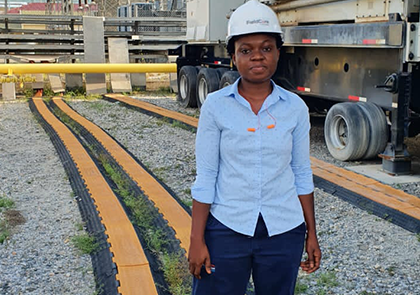
Shortly after graduating, Leticia undertook internships at Vodafone Ghana and General Electric (GE). After completing her internship experience in 2014, Leticia was offered a Controls Engineer position within GE, and in 2017 she accepted a position at FieldCore.
A GE company, FieldCore, is a global industrial field services company that Leticia is still working for today. With the experience she gained over the years, she was able to familiarize herself with power generation technologies. However, she notes that there is increasing development inside the industry.
She points to digital twin technology as a fascinating development in the industry. Digital twin technology is a virtual model of a process, product, or service. Utilizing this technology, Leticia says, helps with predictive maintenance.
"Being able to create a virtual model of a gas turbine to forecast performance issues in time for corrective action, optimizing operations, and having visibility of when a unit needs maintenance is pretty fascinating to me," Leticia said.
As a field engineer, Leticia works on different projects over a period of time, so the daily responsibilities aren't always fixed. There may always be something new to do. However, she is familiar with gas turbines and their control systems - and those are the constants in her work.
"I'm typically responsible for the installation, maintenance, and operation of the gas turbine's control system. For a new unit, that would include calibration of all instrumentation, panel setup, logic verification, and systems commissioning. For unit maintenance, there's still instrument calibration & inspections, part replacement, and returning the unit back online. And in operations, my job would be to support the customer in keeping things running smoothly: unit monitoring, fault-finding, and issue resolution," she explains.
PLCs and SCADA systems in the industrial world help with the overall control of the industrial system. Mastering the machinery is important for engineers and engineering practitioners. With added automation technologies making the systems more complex but increasingly more efficient, engineers are beginning to face a learning curve.
"Throughout my career, I have worked with a particular control system, albeit with some variation. This year, I decided I wanted to expand my portfolio. After some consultation, a course in PLC and SCADA emerged as the best option to get that foundation I needed to broaden my expertise. Due to my work schedule, attending an in-person class was not on the table, so I started looking for online options. A colleague mentioned EIT, where he had taken a master's some years earlier. So, I went to the website and got enrolled," Leticia said.
Now that she has graduated, Leticia doesn't intend on slowing down whatsoever. "I intend to remain in the engineering space, honing my skill set and ultimately taking on roles in project engineering and plant management," she concluded.
We wish Leticia well in her ongoing engineering career and are immensely proud to have her as one of our alumni.
In this time of global market uncertainty, the one thing that we know for sure is that the world needs energy. It’s not only essential to our daily lives but needed in increasingly larger quantities to support economic and social progress, build a better quality of life, and support a sustainable future.
However, for developing countries, the need for reliable and affordable energy is more fundamental. Reliable energy supply can help improve industry, agriculture, trade, and transportation. These are the crucial building blocks that help people escape poverty and create better lives and communities.

Since 2007, South Africa has experienced widespread rolling blackouts as energy supply consistently falls behind demand. The country’s primary power generator, Eskom, began load shedding in an attempt to prevent the country’s entire power grid from collapsing. This hastily implemented plan has affected energy reliability in South Africa to this day could possibly remain for at least the next “five to seven years.”
Power outages can result in substantial financial losses, quality issues, occupational safety hazards, and time delays that could lead to lost business. As a result of this, many South African consumers quickly invested in diesel-powered commercial standby generators to keep their operations running.
However, the unprecedented 2020 coronavirus lockdown regulations and the sudden increase in the number of people staying at home meant generator manufacturers and installers experienced a significant slow-down in demand. According to sources, some engineers in commercial standby generator installation companies had their wages cut by 30 percent during the lockdown.
As restrictions begin to ease and people begin to return to work, the sector is slowly starting to recover. However, some companies are still opting to let a large portion of employees work from home. This has produced an increased demand for more residential solutions, such as battery-based backup systems.
While generators are a quick short-term solution, battery-based systems are much more effective for long term regular power failures. As they are quick and easy to implement and much quieter to operate, there are several benefits over standard generator systems.
University of Western Cape’s Energy Storage Innovation Lab (ESIL) has been researching how they can improve battery performance to become a viable method of combatting the effects of blackouts. They believe utilizing battery-based backup systems will contribute to GPD growth through meaningful job creation and make use of South Africa’s mineral deposits and mining industry.
“It’s only a matter of time: future batteries and supercapacitors are going to change the world,” says Head of ESIL, Professor Bernard Bladergroen.
“Renewable energy combined with an energy storage device such as a battery that could deliver electricity at the cost of electricity from a power station would be a gamechanger – and the future could be bright for Africa.”
Therefore, residential energy storage that is not run on fossil fuels is a great idea for households that need to remain electrified. The instability of energy grids in a world with a changing climate and global shifting perspectives of the future of work produces more career choices for engineers in the electrical engineering field.
In the field of civil and structural engineering, urban stormwater management is a complex and challenging issue. As cities continue to grow, so does the number of impermeable surfaces — those that do not allow water to infiltrate the ground. From concrete sidewalks to parking lots, excess stormwater runoff from these structures can have serious adverse side effects on the surrounding ecosystem.
In more regional areas, rain can soak into the ground to be absorbed and released by plants. By contrast, when rain hits water-resistant surfaces in urban areas, it causes runoff, and water begins to collect sediment, bacteria, oils, metals, and other known pollutants. It has long been a civil engineers' tradition to direct stormwater into nearby systems to be treated at wastewater facilities or discharged directly into waterways.

However, as cities expand, significant precipitation events are having a higher chance of overwhelming stormwater systems. Scientists are warning that the effects of global warming may cause more rain to fall in one storm than an entire year prior. This means that countries with aging or poorly designed infrastructure are falling behind in their ability to manage runoff.
For example, Mumbai, India, has experienced its wettest monsoon season in more than 61 years. Torrential rains halted city life as many establishments, transport links and homes were submerged in waters waist deep. The coronavirus crisis impacted drain cleaning throughout the city, worsening the effects of devastating floods across the city.
An important legal consideration for most construction projects is to ensure that the final build won’t worsen downstream flooding for a particular area. On the stormwater front of a project, the engineers need to look out for that when runoff does occur, the interventions help:
- Reduce erosion
- Minimize pollution
- Prevent flooding
More water diverting infrastructure is necessary to achieve less flooding and mitigate the amount of water overwhelming a drainage system. One method of stormwater management would be to increase water infiltration through the inclusion of permeable surfaces. This approach would allow stormwater to still reach soil while reducing runoff from urban infrastructure.
Topmix Permeable is a fast draining concrete pavement solution that rapidly directs stormwater off streets, parking surfaces, driveways and walkways. This efficient approach to stormwater management would help reduce environment impacts, costs and maintenance efforts. Topmix Permeable’s video of their innovative pavement recently went viral online.
Topmix Permeable’s video, while impressive, saw them receiving critique. The concern among some of the online civil engineering community was that sediment buildup would occur rapidly if stormwater and other elements filtered in below the road surface at such speed. They caution that pavement as permeable as Topmix Permeable would require a lot of maintenance, and expert level drainage - making it tough to implement in roadways.
Nonetheless, all permeable pavements should have stone reservoirs below the surface. The stone reservoir is another fine art the engineer must perfect to create effective permeable pavements. The stone reservoir is generally made of uniformly sized stones that create enough gaps underneath the porous surface. It then temporarily stores water when precipitation is occurring and then slowly moves it off. Nevertheless, Topmix Permeable does look like an intriguing development in pavement that could lessen the chance of flash flooding for cities.
The company says their permeable pavement can provide relief to aging stormwater infrastructure inside the cities. Permeable pavement is still considered a new and developing avenue of the civil engineering world. It is to see much more attention as stormwater drainage continues to make headlines due to added precipitation. If some form of it is to be implemented on roadways in the future, it would require careful design features and construction techniques.
Civil engineers will be keeping an eye on the development of permeable pavement. It may appear at their next project build. Several configurations of how to implement permeable pavement are becoming known as engineers try an assortment of different styles. If these kinds of porous pavements can limit the number of floods worldwide, more and more civil engineers will be looking to lay them at their next project.
Prepare for the future of road construction with EIT’s Professional Certificate of Competency in Fundamentals of Road Construction.
Works Cited
Matchar, Emily. “This Concrete Can Absorb a Flood.” Smithsonian.com, Smithsonian Institution, 5 Oct. 2015, www.smithsonianmag.com/innovation/concrete-can-absorb-flood-180956830/.
“Mumbai Records Decade's Highest 24-Hour October Rain, 2nd Highest Monthly Rain in 10 Years.” Hindustan Times, 15 Oct. 2020, www.hindustantimes.com/mumbai-news/mumbai-records-decade-s-highest-24-hour-october-rain-2nd-highest-monthly-rain-in-10-years/story-5DGtX98zNszUW9jkdXMEWK.html.
Hailing a flying taxi will no longer be just a concept found in science fiction movies. A Japanese company called SkyDrive recently tested a single-seat prototype straight out of Back to the Future. The company has unveiled its electrical vertical takeoff and landing (eVTOL) vehicle, also known as a flying car. The vehicle looks to be a significant step forward toward the future of air mobility.
On the 25th of August 2020, SkyDrive successfully tested prototype SD-03 at the Toyota Test Field in Japan. The flight saw the vehicle hover a few feet off the ground for around 4 minutes within a protective cage. However, the test's success has now given SkyDrive enough impetus to broaden the testing environment and generate safety data in a larger area. Ultimately, this data will be used to make a case for the flying vehicles in transportation.
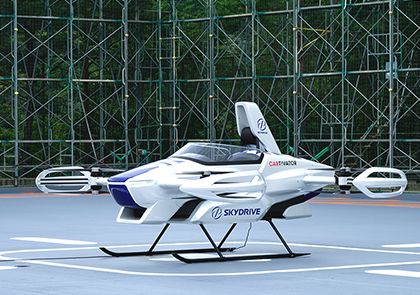
SkyDrive says it has long been their goal to develop the world's smallest flying car model. The SD-03 measures in at just 2 meters high, 4 meters wide, and 4 meters long, making it the smallest eVTOL in the world right now. The one-seater craft takes flight thanks to eight electric motors that power several rotors positioned in four locations around the vehicle's body.
SkyDrive says that if one of the eight motors fail on the SD-03 prototype, the other motors will play a backup role and keep the vehicle flying. The 'car' also has two front lamps and one red tail lamp — the first signs that it might conform to some form of aerial traffic system in the future.
Chief Technology Officer at SkyDrive, Nobou Kishi, has also predicted when he thinks a flying taxi service may come about utilizing their technology.
"The crewed flight that we achieved this time is the culmination of the results that SkyDrive has accumulated so far for technical verification. We have been working step by step, such as designing and testing electric propulsion systems, flight control systems, airframe structures, and introducing equipment for airframe conditions during flight tests. We will continue to work on technological development and type certification so that we can start a safe and reliable flight car navigation service in 2023," Kishi said.
Sky race
Another technology company keenly interested in air mobility is Uber, who just recently launched Uber Air. They have vehicle partners who include Aurora Flight Sciences, Bell, Embraer, Hyundai, Jaunt Air Mobility, JOBY Aviation, Overair, and Pipistrel Vertical Solutions.
Aerospace company Boeing and automobile manufacturer Porsche had also conducted autonomous tests on prototypes of their flying cars back in 2019. They say their vehicle has space for two to four people and a range of 50 miles.
Naturally, due to Boeing's foray into flying car manufacturing, rival Airbus has been tasking their engineers to develop a prototype of their own. There is, therefore, no lack of competition in the air mobility industry. Nonetheless, it is impossible to say which company may go public with a certified consumer experience first.
SkyDrive's two-seater concept vehicle is the company's next focus. The SD-XX is a customer-focused eVTOL that can fly up to altitudes of up to 1,640 feet.
"We are extremely excited to have achieved Japan's first-ever manned flight of a flying car in the two years since we founded SkyDrive in 2018 with the goal of commercializing such aircraft," SkyDrive CEO Tomohiro Fukuzawa said.
"We aim to take our social experiment to the next level in 2023, and to that end, we will be accelerating our technological development and our business development."
Works Cited
sd2020 投稿者: "HOME." 株式会社SkyDrive, skydrive2020.com/archives/3506.
From the online classroom to the world's leading producer of diamonds by value, many EIT graduates are using their qualifications to contribute to the operations of Debswana Diamond Company mines located across Botswana.
Established in 1969 and owned in equal shares by the Government of the Republic of Botswana and The De Beers Group of Companies, Debswana is one of the world's leading diamond producers and Botswana's largest employer with over 5,000 employees and 6,000 contractors.
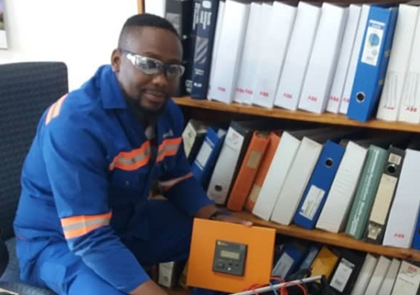
A self-proclaimed 'people-based organization,' Debswana places great value in its employees' training and development, attributing a large part of their success to their ability to develop and sustain a qualified and skilled workforce.
EIT has helped develop the skills and knowledge of eleven Debswana employees. With graduates coming from a range of EIT programs including our 52726WA - Advanced Diploma in Electrical Engineering, 52810WA – Advanced Diploma of Mechanical Engineering Technology, 52708WA – Advanced Diploma of Industrial Automation, and Bachelor of Science (Industrial Automation).
Our unique online learning experience allows students to develop their engineering skills remotely, meaning Debswana's employees can continue working while gaining globally relevant qualifications that further augment their understanding of the industry they work within.
"I chose this course because I have always wanted to be an electrical engineer. My studying experience with EIT has been consistently good. EIT has a lot to offer and is very capable," says 52726 - Advanced Diplomas in Electrical Engineering graduate, Johnson Itumeleng.
"I have learned a lot, and I am executing my daily work in a much more professional manner with what I have learned from EIT."
Johnson started his career in engineering as an apprentice at the Orapa Technical College in 2007. After spending four years as an apprentice, Johnson was employed by Debswana in the Power Distribution sector. He now works as an Industrial Electrician in Debswana's Orapa Mine.
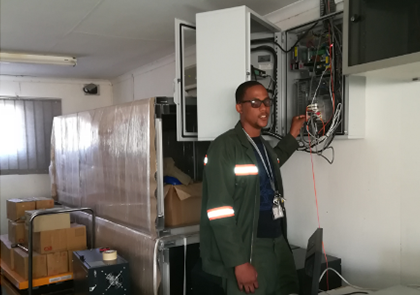
Discovered in 1967 and in operation by 1971, the Orapa Mine is the world's biggest open cast mine. Orapa is currently mining at a depth of 250 meters and is expected to reach 450 meters by 2026.
Orapa is one of Debswana's four mines, along with the Damtshaa, Jwaneng, and Letlhakane operations. Debswana's vision is to be a global bench-mark diamond business. To achieve this, they are setting increasingly demanding targets, embracing industry change, and making meaningful contributions to communities' development around its mines and Botswana at large.
As plans for Debswana's driven future became clear, 52708WA – Advanced Diploma of Industrial Automation graduate Goratoane Rivaldo Rabodietso began studying to keep up with the digitization and automation that he saw encroaching into the industry.
"The most interesting development in our industry is the use of smart instruments which can be calibrated and operated remotely," Goratoane said.
"The use of smart trucks at the mining pit is amazing as well - it can even perform an alcohol test on the driver to check their fitness prior to the operation, which protects the most valuable assets of the company."
Due to its technical and machine-driven nature, Debswana prioritizes the safety of its personnel and operations. All the sites boast impressive records, such as the Jwaneng Mine achieving one of the lowest disabling injury incident rates in Botswana and the Orapa and Letlhakane Mines achieving 2 million fatality-free shifts.
The continuing success story of Debswana Diamond Company is one of excellence and engineering success. EIT is thrilled to have played a part in equipping some of its workers with the skills and knowledge that further assists one of the most notable companies in Botswana's history.
Ray Crawshaw is an engineer who currently works in the mining industry in Australia. He is also an Engineering Institute of Technology (EIT) alumnus, having studied our 52726WA - Advanced Diploma of Applied Electrical Engineering and our Master of Engineering (Industrial Automation).
Ray has spent his working life pursuing more practical and hands-on jobs and has filled a plethora of roles in several countries and regions. He truly has had a decorated career, with 35 years of experience in the oil & gas, power generation, and mining sectors. Later on in his career, Ray looked to add higher education qualifications to his resume, further building upon his skills and technical knowledge. Nearing retirement age is not slowing Ray down — he is more determined and hungry for growth in his academic and working career than ever before.
A son of a farmer, Ray went to school in a country farming region in New Zealand. When he was 11 years old, his father tragically passed. In 1966, he started living on his uncle’s farm. His uncle encouraged him to take up a trade so that he could find work.
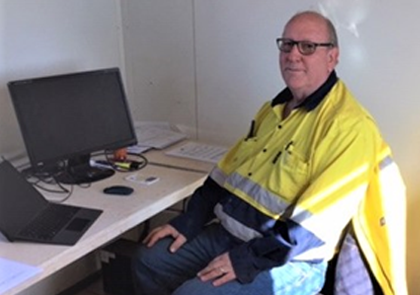
Ray applied for a job as an electrician and was soon employed by a power supply authority in New Zealand. He started as a substation cadet. Ray ended up spending eight years with the Bay of Islands Electric Power Trust (now known as Top Energy). There, he earned a trade certificate in the first two years of his four-year apprenticeship. He still, however, had to complete the 8,000 required hours.
In 1978, Ray moved to Australia for work, which saw him fulfilling an altogether different role. He became a fireman on a train that transported freshly cut sugarcane. A year later, he went back to New Zealand for Christmas and incidentally met his future wife.
Six months later, Ray was married and began working for New Zealand’s only oil refinery, Marsden Point Oil Refinery. Refining NZ, the company that operated the refinery, was spending several billions of dollars upgrading it. He spent two years on the refinery, saving money to buy a house for his family, which was soon to grow.
Back in his hometown, Ray decided to start a business that sold whiteware, such as fridges and stoves. His wife oversaw the operations of the store.
Ray began to do commercial and domestic contracting work. His industrial experience, however, took precedence and saw him constructing mills in the north of New Zealand. Along with a crew of 50, they ran the project from start to finish. Ray then returned to contracting himself out to dairy farmers and abattoirs.
Chasing the boom
Ray and his wife flew to Australia for Christmas in 2007. Looking for a change of scenery, they decided to pursue opportunities during Australia’s mining boom. He was soon working on the electrical systems on a plethora of mines in Australia.
Due to his years of experience, Ray was promoted to supervisor and superintendent roles on the mines. He then was head-hunted while working at one of the mines, which allowed Ray to pivot to the oil and gas industry. He became a construction area manager on Gorgon Barrow Island’s LNG (Liquefied Natural Gas) Plant for a company named Leighton Contractors Oil and Gas. It was the largest LNG plant in the world built at the time; 10,000 people were employed to work on the project, and it cost a total of 60 billion dollars (AUD). Ray was the area construction manager that laid four million kilometers of cable.
A year and a half later, Ray began work for ConocoPhillips — an American oil and gas company — on their Gladstone Curtis Island site in Queensland, Australia. He worked as a Programs Completion Manager working on their LNG project. Soon he was flown out to work on another project, this time for Chevron back at Barrow Island Gorgon.
There was no doubt at this point that Ray was an engineering professional in all sense of the word. However, Ray himself had an overwhelming feeling that he was missing that formalized ‘Professional Engineer’ recognition. He set out to find a way he could become a professional engineer while continuing to work.
The EIT connection
“Since leaving school, I hadn’t done any formal education for over nearly forty years. I just had the trade certificate. I had a lot of experience over the years, had run my own business, and had been in many high profile positions. But, I didn’t have any qualifications to back it up,” Ray said.
In the year that Ray began work on Gorgon Barrow Island in 2012, he enrolled in the 52726WA - Advanced Diploma of Applied Electrical Engineering with EIT, finishing it in the year 2014. Witnessing the encroachment of technology into the engineering disciplines he was interested in, he wondered if he should become more skilled in automation.
Ray had already worked for Chevron for a year when he enrolled in our Master of Engineering (Industrial Automation). He seamlessly integrated what he was doing at work into his thesis for EIT. He became the E&I area construction manager overseeing the construction and pre-commissioning of engineering equipment crucial to the LNG operations on those projects.
“At Chevron, they were testing the gas wells for mercury, and they thought they aligned with international standards, but by the time it got to the plant itself, the mercury levels were a lot higher than the standards,” Ray explained. As a construction manager, he was given the task to go into the plant and install online mercury analyzing equipment. The master’s studies came into good use — Ray found he could consolidate what he was learning in his automation studies to find a more efficient way of detecting mercury levels.
“I thought there must have been a better, less expensive way of testing mercury levels. Using modern technology, I looked into what we could devise that could help us analyze. We ended up using electric devices that would use surface acoustic waves for measuring mercury. And since the master’s with EIT was to do with automation and control, I had to use my knowledge of PLCs and SCADA and HMI. So I correlated the thesis with the work I was doing there.”
Beginning the golden years
Ray entered his sixties in 2017 and was as hungry as ever to continue working in the world of engineering. After he finished at Chevron, he found it was harder and harder to get work — he couldn’t find a job for ten months. As a consequence, he began looking for work overseas, hoping a company might see the benefit of his immense experience.
He managed to snag a job as an LNG plant commissioning manager in San Antonio, Texas, in the United States for a company named BHGE. The job saw him being ported to Port Harcourt in Nigeria as well — a region that was going through a civil war at the time. After a year and a month of working in that role, he moved back to Australia.
In Western Australia, Ray found work again. This time as a project manager for Synergy, Western Australia’s leading provider of electricity and gas. He oversaw projects at the Mungarra Gas Turbine Power Station and the building of Black Start generator for a GE Gas Turbine that supplied the Western Power grid. He was highly lauded in the position and given an award for delivering it on time and under budget.
Ray is currently working at Fortescue Metals Group Mine, a global leader in the iron ore industry. He is working as a construction and commissioning manager on-site, building mining hoppers and shifting them from location to location. He is on-site for three weeks at a time as he is employed on a FIFO (fly-in, fly-out) basis. Ray’s contribution to the engineering world has been invaluable.
“Considering my age, the two qualifications I received through EIT did enhance my career in terms of positions and employment — not only in Australia, but overseas as well. I recommend for anyone to do qualifications with EIT because the online delivery mode is utterly convenient,” Ray said.
“Now, with EIT offering a doctorate, I might consider doing it. I will be nearly seventy by the time I finish,” he laughed. “But it would be worth it.”
The Engineering Institute of Technology (EIT) has alumni from over 40 countries and is one of the only institutes in the world that can boast a truly global spectrum of learners due to its online student body. However, EIT also has two campuses in Australia that are ready and able to welcome both local and international students for on-campus studies in 2021.
The COVID-19 pandemic has caused a delay in international students traveling to Australia. Encouragingly, EIT has the ability to allow students to stay abreast of their studies while waiting for travel restrictions to lift due to its unique, refined, online delivery model. EIT has been conducting and perfecting online engineering education for the last ten years. The Engineering Institute of Technology has therefore remained open throughout the year without disruption, and is offering future on-campus students an option to begin their studies online and finish the qualification on campus in Australia when borders re-open.

The Engineering Institute of Technology has two campus locations in Australia (Perth & Melbourne) and is planning to announce more in the future. The unfortunate reality that COVID-19 has presented international students who wish to complete their degrees on-campus in Australia with are the travel restrictions that have been enacted. However, at EIT, we have over ten years of experience with delivering high-quality engineering education to students around the world via our unique delivery model. For on-campus studies, we currently cater for both bachelor’s and master’s students.
Bachelor of Science degrees in Industrial Automation, Electrical Engineering, Mechanical Engineering, and Civil and Structural Engineering are EIT’s undergraduate programs available for on-campus study in Perth, Western Australia. EIT also offers Master of Engineering programs in the same fields in both Perth, Western Australia, and Melbourne, Victoria.
EIT’s future on-campus master’s students have been able to commence their qualifications via a unique September intake. These master’s students will complete one unit online and then transition to the campus once travel restrictions are lowered.
The benefit of completing one of the units of the master’s degree online will assist students in becoming accustomed to the unique delivery model EIT employs. They will also become immersed and engaged in their academic journey. By the time they reach the campus, they will be ready to hit the ground running.
The Engineering Institute of Technology is monitoring international travel regulations extremely closely. In the event that travel restrictions are still in place for our February 2021 intake, both the bachelor’s and master’s degrees will continue fully online.
Transitioning from online to on campus
Once travel restrictions are lowered, EIT will be welcoming students with open arms. We recently hosted a discussion with one of our master’s students who is currently completing his Industrial Automation qualification through EIT. Felix Okoh is a Nigerian student who went from studying through EIT’s online campus in his home country to relocating to Australia. He is one of our revered master’s students who has taken the option of completing his course on-campus.
In 2018, Felix was looking for a premium education provider that would further build his skills based on his prior experience. He finished two units in his hometown before deciding to open up a world of opportunities by completing his qualification in Western Australia.
“With my experience in the oil and gas industry in Nigeria, combined with a Bachelors in Electrical and Electronic Engineering, I decided Industrial Automation was one of the fields that would keep me competitive within a wide range of industries,” Felix explained. “I chose EIT because of their specialization in Engineering, more affordable tuition fees, and the accreditation of its programs.”
Felix says that he was at first worried about combining full-time work and part-time online studies, but was quickly impressed by the knowledge of the lecturers and how seamless the learning environment worked for him. After successfully receiving his VISA, he managed to relocate to Australia to complete his studies.
“The online platform affords you a lot of flexibility,” Felix said, “But I decided to go on-campus because I read up a lot about Australia and the opportunities the country has. For students who have studied in Australia for two years and above, you can apply for post-study work rights that let you work in Australia.”
Once Felix commenced his studies in Australia, he explains he enjoyed the campus environment and meeting the capable lecturers that he had become so accustomed to on the online platform. He has made friends with other international students on campus and says that he is building a network of colleagues now that he knows he can rely on in the future.
“I am looking forward to having Australian work experience and being admitted as a member of the prestigious Engineering Australia. I encourage students to look into EIT and work toward improving their careers,” Felix concluded.
You can follow in Felix’s footsteps when you apply for an on-campus bachelor’s or master’s degree with the Engineering Institute of Technology.
The Engineering Institute of Technology (EIT) is a unique global institute, delivering online engineering short courses, diplomas, and degrees. Students around the world log into EIT’s synchronous online virtual campus to network with other students and lecturers in real-time. Underpinning this live online academic delivery are EIT’s Learning Support Officers (LSOs), who play a key role in helping students succeed in their studies. They become a student’s trusted advisor and provide guidance and encouragement on a student’s learning journey.
“We are the dot connectors for everything a student needs to complete a qualification or course,” said Holly Ross, an LSO based in New Zealand. Holly has been working with EIT for the last seven years, watching the institute grow from strength to strength. “I have gone from seeing our systems and procedures changing rapidly with the growth of the company and the ever-changing world of technology.”
Learning Support Officers walk alongside students every step of the way as they progress in their course. They constantly check-in with their students and iron out any problems the students may be having. If a student is falling behind, the LSO gently (and virtually) nudges the student to help them progress successfully in their studies.
How it all starts
“My role starts once a student has applied for a Professional Certificate or an Advanced Diploma course. I have specific courses that I manage, so if a student applies for one of those courses, their application comes through to me by email,” explains Thelma Bango, an LSO operating out of the South African EIT office. “I then assess the student’s application for suitability, and I either send them an acceptance email in the course or a request for more documentation to support their application.”

Once students are fully enrolled in the course and begin working to earn their qualification, their various studying styles emerge. The Learning Support Officers face the task of keeping tabs on EIT’s diverse student body. Holly says she tries to encourage students at the start of their courses to take it ‘one step at a time.’
“During the course, we check student progress. We contact students who are falling behind and send them letters stating where they need to catch up. Most would normally do their part to ensure they catch up when they get these letters,” said Isabel Sibanda, an LSO based in Zimbabwe.
For diligent students who more effortlessly rise to the challenge of their online qualifications, LSOs give sprinkles of praise to further encourage them to keep pushing forward with their course. In some cases, students are doing their first online qualification, which may seem like a daunting task, but with EIT’s LSOs, their journey becomes easier. EIT Learning Support Officers understand all too well that many students combine their studies with full-time work and they are well experienced in providing the necessary support to assist those students in staying on track.
“The beauty of our work is that we understand that our students have work, family, and life commitments, so we give them an option to ask for an extension to their assignment submission dates, within reason, of course,” said Thelma.
Across the universe
The Learning Support Officers of the Engineering Institute of Technology assist students from an assortment of countries across the globe, including but not limited to: Canada, the United States, United Kingdom, India, South Africa, New Zealand, and Australia.
“Dealing with students from different cultures, nationalities, and continents reveals just how different people are even though the common goal is the same; to attain a qualification with which one can better themselves,” Thelma said.
The Learning Support Officer also experiences news-making world events that unfold and affect their students’ lives. Sisipho Phakamisa, another of the LSOs in the southern African region, explains that she has learned perspectives from students who this year have experienced Australian wildfires, COVID-19, retrenchments, marriages, births, and everything else in between.
Moreover, the LSOs have to be acutely aware of the various time zones students are in. “I have become accustomed to the time differences between students. As big and far away that the continents and countries are, the interaction with students makes the world feel a little smaller,” Sisipho says.
When a course has run its course
Once a course is on the cusp of being completed, the LSO team at the Engineering Institute of Technology encourages students to reach that finish line. Once the students have graduated from the course, they are in charge of putting together the students’ graduation packs. The pack includes their stamped qualification they just earned.
“At the end of each course, I am tasked with the wonderful duty of graduating students from the intake by compiling and mailing out their graduation packs. There is no greater feeling than graduating your class at the end of an 18-month journey and knowing that someone has an additional qualification under their belt, all thanks to your assistance throughout the course,” said Thelma.
While the LSOs wield much power, students are also encouraged to provide feedback surveys to comment on whether or not they are satisfied with the support they are receiving. Keeping students on track is important work, and takes a balance of compassion but also firmness. The Engineering Institute of Technology’s Learning Support Officers are continually refining the processes they employ to help students achieve their dreams. With this ‘art of support,’ LSOs help students earn a career-changing and life-changing qualification.
EIT’s Academic Resources, Higher Education, and IT departments have been working in the background over the past few months to revamp the EIT eLibrary, hosted on Moodle. We are pleased to announce that the official launch date is 1st October 2020!
What is happening?
We have updated the EIT eLibrary to a new, more user-friendly format. This includes new information to support students throughout their course, easier access to the IDC technical manuals, and a complete overhaul of the Open Access Resources content.
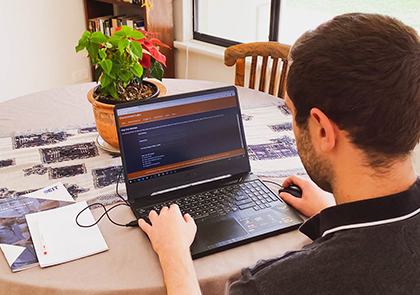
The goal of this update is to improve, modernize, and re-organize the learning resources available to students so that it is easy to navigate and provides more useful content. Some of the major changes include:
- An upgrade to the IDC technical manuals viewer to ensure eBooks are easier to read online
- A complete overhaul of the Open Access Resources content to include a centralized listing of reputable open access publishers as well as lesser-known open access journals
- A new section called Study Support with tips, tricks, and information on report writing, general writing skills, and exam preparation
- An updated library of our master’s graduates’ thesis papers
The new eLibrary will go live on Thursday, 1st October. There will be no changes to student access – everything will still be hosted within Moodle, and students can access the platform in the same way as before. The Academic Resources team will be constantly working on new updates and added content to ensure continuous improvement to the resources we offer.
We hope the new eLibrary will be a welcome improvement for all current and future students.
The industrial facility or smart-factory of the future is, in fact, here today. Automated processes ensure efficiency, and round-the-clock monitoring promises ongoing operations. However, not a lot of consideration is given to the crucial sensors in an industrial set up that makes this possible. Industrial sensors are the smaller but omnipresent element within those industrial facilities and factories, monitoring the entire ecosystem of an industrial operation and making sure those processes continue without a hitch. As sensor networks are brought online and form part of the Internet of Things (IoT) future, keeping them online is imperative. Industrial sensors typically run off of lithium-ion batteries and inevitably need replacing. A new startup is innovating in the space and taking the battery out of the equation altogether.
Smart factories and other industrial operations face replacement costs since sensor batteries eventually deplete. Some sensor batteries can last for up to a year before they need to be replaced.
However, a startup named Everactive says they have the answer to eliminating battery requirements that modern-day IoT sensors have. They are launching a self-powering sensor without a battery that can last up to 20 years.
How does the sensor work?
The sensors have come a long way since their inception. The initial concepts were bouncing around inside the minds of the two future co-founders of Everactive who were attending the Massachusetts Institute of Technology. David Wentzloff and Benton Calhoun focused their academic careers on low-power technologies. The former on low-power digital circuits and memory, while the latter focused on low power radios. Their combined skills have given birth to their new sensor — the Eversensor.
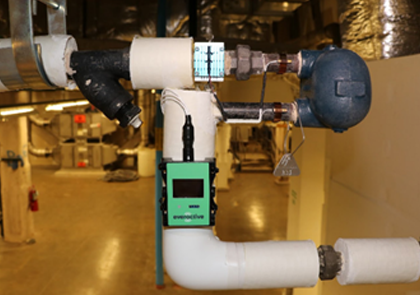
“It’s all enabled by the ultra-low-power chips that support continuous monitoring. Because our source of power is unlimited, we’re not making trade-offs like keeping radios off or doing something else [limiting] to save battery life,” Everactive Co-Chief Technology Officer David Wentzloff said.
Everactive says the ultra-low-power integrated circuits harvest energy from indoor light and vibrations. There is also an outdoor self-powered sensor available that can utilize small collar cells to power the sensors. The Eversensors can be fixed to key infrastructure in industrial operations and can sense when those machines stop functioning. The sensors do this by measuring temperature, acceleration, vibration, pressure, and more.
Everactive says the sensor meets all of the sensing, processing, and wireless capabilities that any battery-powered sensor does. Process optimization and reduced maintenance cost of both the sensors and industrial machinery are just some of the benefits of sensors working around the clock.
“Removing the need for batteries solves one of the key limitations of the IoT and represents a fundamental paradigm shift, allowing our customers to deploy wireless sensors at scale and gain access to new, high-value data-driven insights,” Bob Nunn, the CEO of Everactive, said.
The company is boasting the world’s lowest power radios and are deploying them for some of the biggest industrial companies in the world. With batteryless technologies generating much interest in the world of industrial engineering, more battery-intensive technologies could see new opportunities in a plethora of industries.
Works Cited
“Industrial IoT - Batteryless Sensors Data Analytics.” Everactive, 31 July 2020, everactive.com/.
Zach Winn | MIT News Office. “The Factory of the Future, Batteries Not Included.” MIT News, 20 Aug. 2020, news.mit.edu/2020/everactive-sensors-0820.
An electricity startup company in New Zealand says they are working toward a launch of a world-first wireless energy transmission system they assert will be opening up the world's access to power. They reportedly will be using tele-energy technology to enable long-range wireless energy transmission that is safe, reliable, and cost-effective. Echoing the work of inventor Nikola Tesla, the company hopes to democratize access to electricity. If the company succeeds in rolling out the technology, it could usher in a new era of electrical engineering.
Nikola Tesla, who famously engineered the alternating current system toward the end of his life, was attempting to engineer a system where electricity could be transmitted to single antennas in consumers' homes. In turn, he hoped the wireless energy would power entire households and give everyone in the world access to electricity — the attempts at figuring out the technology led to the creation of the Tesla coil. Tesla, in the 1890s, managed to light a bulb across a distance of two miles using a Tesla coil.

Since then, wireless electrical transmission has been an elusive technology that no single company has been able to implement at a level that consumers could benefit from. However, a government-backed startup in New Zealand seems to have picked up where Tesla's work left off. Emrod, the startup in question, says they have developed a safe method for wirelessly transmitting electric power across long distances.
The technology utilizes electromagnetic waves to transmit energy wirelessly over vast distances. New Zealand's second-largest electricity distribution company, Powerco, will be first in line to test the new Emrod technology.
Tech entrepreneur Greg Kushnir spearheaded the technology. Surprised by how little development of wireless electricity technology was being worked on in the industry, he set out to recruit scientists and engineers from a company named Callaghan Innovation.
"We have an abundance of clean hydro, solar, and wind energy available around the world but there are costly challenges that come with delivering that energy using traditional methods, for example, offshore wind farms or the Cook Strait here in New Zealand requiring underwater cables which are expensive to install and maintain," said Kushnir.
"I wanted to come up with a solution to move all that clean energy around from where it's abundant to where it's needed in a cost-effective, eco-friendly way. Energy generation and storage methods have progressed tremendously over the last century, but energy transmission has remained virtually unchanged since Edison, Siemens, and Westinghouse first introduced electric networks based on copper wires 150 years ago."
How it all works
The company has patents pending for its technology, so the more proprietary technology the company is using is mostly under wraps for the time being. However, they do say they are working in frequency ranges in the ISM (Industrial, Scientific, and Medical) band - which are typically used in WiFi, Bluetooth, and RFID.
The prototype point-to-point transmission system Emrod engineered, along with Callaghan Innovation, impressed Kiwi government funders. To further demystify the tech the startup is working on, Kushnir spoke to New Atlas.
"Transferring energy with microwaves has been around for decades. In the 70s, NASA showed it could support a helicopter drone in the air, charging it with microwaves from the ground. It's been around for a while. What's changed in the last few years is mostly metamaterials technology. New materials that allowed us to convert the energy back into electricity very, very efficiently. That was what made it viable for commercial use. Before that, it's been around, but mostly used for military purposes," he said.
IT is the proprietary beam shaping, metamaterials, and rectenna technology that Emrod is keeping under wraps for now.
Kushnir goes on to say, "Electromagnetic metamaterials can absorb electromagnetic radiation and turn it into heat, or electricity, or make it go away. It's essentially stealth technology, that's what it's been used for in the military."
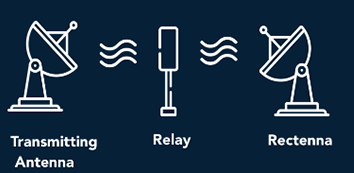
The startup assures critics that their system will produce no waves, no radiation, and no environmental impact. They have been testing their tech, sending 'a few watts' between two points spaced 130 feet from each other. The startup ultimately has faith that they are on the right track:
"The statistics are pretty compelling. We are talking about a potential 50 percent increase in sustainable energy uptake, up to 85 percent reduction in outages and up to 65 percent reduction in electricity infrastructure costs due to the Emrod solution," Kushnir concluded.
The startup wants people to imagine the possibilities when power can be accessed anywhere. The startup hopes this technology can finally power rural communities who don't have much access to electricity. If they get wireless electricity for consumers right, the startup might be hailed as one of those that managed to achieve what Nikola Tesla dreamt of over a hundred years ago.
Works Cited
"Press Release: NZ Start-up Launches World-First Long Range Wireless Power Transmission." Emrod Energy, 2 Aug. 2020, emrod.energy/press-release-nz-start-up-launches-world-first-long-range-wireless-power-transmission/.
silvae/Depositphotos, and Emrod. "New Zealand's Wireless Power Transmission: Your Questions Answered." New Atlas, 4 Aug. 2020, newatlas.com/energy/wireless-power-transmission-emrod-interview/.
It is estimated that in the United States alone, elevators travel up to 4.5 million miles every single day. The 31st of July is International Talk In An Elevator Day — it encourages people to engage with someone in an elevator, instead of looking down at their devices and ignoring their surroundings. However, for the first time since ‘Talk In An Elevator Day’ was coined, engineers and scientists are warning against striking up conversations in elevators. The coronavirus pandemic has put the day on pause for 2020 — and there is good scientific evidence as to why.
Amid the pandemic, Richard Corsi, Dean of Engineering and Computer Science and a specialist in indoor air quality at Portland State University in the United States, said: “They should put big signs on the elevator: ‘Do Not Speak.’”

He said this because of the risk run by people who are entering elevators during this time, given the close proximity of occupants. The virus has been particularly widespread in the United States, which recently saw its most significant one-day rise in coronavirus tests; 71,484 tested positive in one day.
Corsi, under the rising coronavirus cases, set out to investigate elevator safety in a pandemic using a method that only an engineer would. He created a model utilizing engineering principles akin to fluid mechanics and cross-referenced them to several kinds of elevators and buildings. Knowing there would be thousands of scenarios, he decided to choose one hypothetical scenario.
In his scenario, a mask-less COVID-19-positive passenger rides the elevator alone from the first floor to the tenth floor. During the ride, they speak on their phone and cough into the elevator car, which spreads the virus around.
When the elevator gets to the tenth floor, they exit the elevator. The doors remain open for ten seconds, close, and then the elevator returns to the ground floor. Taking into consideration the opening and closing of the doors and the subsequent circulation of air, plus the ventilation within the elevator, Corsi estimates at least 25 percent of the particles from the first passenger remain inside.
“The main intent of the exercise was just to show that some level of virus can be sustained in the air beyond an infected person using the elevator. I don’t know whether the dose in an elevator is going to be high enough to pose a significant risk, but I would probably take the stairs if possible,” Corsi told the New York Times.
He tweeted out a hypothetical elevator scenario, including the asymptomatic but infected individual traveling ten stories in a residential building. Evidently, this is an engineer doing their calculations, needing a bit more input from the science still being compiled about the coronavirus. Nonetheless, it is an admirable attempt to work with the facts the public is equipped with at the moment and guesstimating — based on what type of elevator someone is riding - whether or not it may be safe.
Moreover, Corsi’s calculations barely begin to cover the risk the floor number buttons pose to the passengers who touch them. Thankfully, Harvard School of Public Health’s Joseph Allen, an Assistant Professor of Exposure Assessment Science has sound advice on what to do if you do find yourself in an elevator as businesses continue to open up:
- Wear a mask
- Load the elevator in a checkerboard pattern
- Face forward
- Announce your desired floor
- Have the person near the buttons select for everyone, using their knuckles
- No conversations
“Workers want to know whether they can really be safe in an elevator, and building owners want to know whether they get elevator capacity to more than one person at a time. Fortunately, the answer to both is ‘Yes,’” Allen said reassuredly.
Engineers, when probed on elevator safety, are erring on the side of caution due to the constant uncertainty of the coronavirus pandemic. Common sense precautions are becoming more important than waiting for the epidemiologists to aptly inform the global population on the safety of elevator rides. The question about elevator engineering and air circulation and quality is a rare moment where both engineers and scientists can revise some of their studies and come up with answers that can better inform those who ride them.
It was hailed as the next giant leap for personal transportation. Now, it seems, the idea has become redundant. The Segway PT was a one-person electric vehicle that was brought to market in 2001 — with extreme hype and expectation. Nineteen years later, the self-balancing, two-wheeled personal transporter is being discontinued. It seems that lower consumer demand for the vehicle has convinced Segway to pull the vehicle from its assembly lines, to instead focus on other projects in the mobility industry.
The discontinuation of one product and the evolution of another is seemingly the great challenge for consumer-driven engineering companies all over the world. As technology advances and some technologies become obsolete, one can look back at how those technologies laid the foundation for newer, more advanced technologies to enter the market.

The Segway PT, while an attractive prospect for consumers, was dogged with scathing headlines whenever a crash of the vehicle would occur — resulting in its 'fair share' of highly publicized sensationalist coverage. Nonetheless, Segway inventor and founder Dean Kamen was praised by fellow entrepreneurs at the unveiling of the Segway back in 2001. Apple co-founder Steve Jobs said, about the Segway PT, that it was the most significant invention since the personal computer and Amazon founder Jeff Bezos called it 'one of the most famous and anticipated product introductions of all time.'
"Within its first decade, the Segway PT became a staple in security and law enforcement, viewed as an effective and efficient personal vehicle," said Judy Cai, Segway president, in a recent statement on the discontinuation.
"This decision was not made lightly, and while the current global pandemic did impact sales and production, it was not a deciding factor in our decision."
Associated Press confirms that the Segway PT currently only accounts for 1.5% of the company's profits. The company is, therefore, looking to debut new products that may buoy their company from now on. Even though the PT has seen a downward spiral in demand at the consumer-level, the transportation industry continues to make strides forward.
The Segway company is not disappearing into the history books, however. The company has introduced a new vehicle to the personal transport industry at the Consumer Electronics Show in Las Vegas in January. Their new concept is a self-balancing electric wheelchair and is named the Segway S Pod.
The company is also designing and selling several variants of lightweight scooters. They continue to innovate in the space and seek an audience in the personal transportation industry. PT's story is one of demand, after all. Demand forecasting and predicting a product's life cycle in the market is good business practice, and something engineers have to grapple with within companies.
When to discontinue a product
Companies tend to design products with lessons learned from their previous endeavors. Apple is one of those companies. The company went from designing personal computers to music players to smartphones. After the introduction of the iPhone, some of the company's different music-playing hardware products very much fell out of fashion, and some were promptly discontinued. The iPod Classic, Nano, and Shuffle are no longer being engineered.
Companies usually discontinue certain products because they are in the process of introducing a new line of products into the market that will render the previous product obsolete.
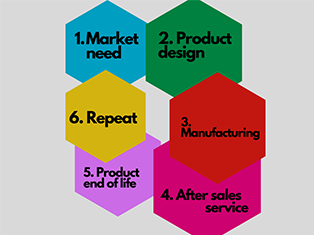
Dr. Kenneth Reid, an Associate Professor in Engineering Education at Virginia Polytechnic, and John Estell, professor of computer engineering and computer science at Ohio Northern University put together an engineering design book, "Engineering Design and the Product Life Cycle: Relating Customer Needs, Societal Values, Business Acumen, and Technical Fundamentals." They sum up the entire engineering design and product life cycle in 9 steps:
- Conceptualization
- Feasibility
- Definition
- Implementation
- Introduction
- Growth
- Maturity
- Decline
- Discontinuance
Business management concepts, coupled with product design and engineering life-cycle theory, are vital concepts to impart on up-and-coming engineers who are entering engineering workplaces or founding engineering startups. Knowing when to introduce products to the market, and when to discontinue, is one of the modern-day challenges for a plethora of engineering companies in a wide spectrum of industries.
For companies that prepare products to sell to consumers and clients, starting the product development process with the end in mind is smart business practice. With how fast technology is advancing, being aware of when to begin producing the next product, and discontinuing the one that came before it is becoming an engineering art form. Reid and Estell conclude:
"Even the most successful, earth-shattering, and monumental designs eventually go out of style, lose their significance or usefulness, or are simply replaced by a superior design. In each case, discontinuance from an engineering standpoint implies more than simply throwing something away. We should anticipate the discontinuance in our design."
Works Cited
Ott, Matt. "Segway, Popular with Police but Not the Public, Hits Brakes." AP NEWS, Associated Press, 23 June 2020, apnews.com/3525b9a69569d57dc41a373e82a8f1cd.
Reid, Kenneth J., and John K. Estell. Engineering Design and the Product Life Cycle: Relating Customer Needs, Societal Values, Business Acumen, and Technical Fundamentals. Momentum Press, 2018.
Lighting design brings together art and science: requiring the designer to apply both creative, visually appealing, and effective spaces. Lighting professionals work in a variety of roles and project areas: malls, hospitals, residences, roads, tunnels, sports arenas, and more. The Engineering Institute of Technology (EIT) is offering a 52856WA - Advanced Diploma of Illumination Engineering and Lighting Design, starting in November, that will equip students looking to go into the lighting industry with the fundamentals of illumination and lighting.
Lighting also happens to be essential for crop-growing in greenhouses, which in turn, helps geographical regions develop food security. The growth lights industry has been gaining momentum in the last couple of years as urban farming gains in popularity.

Specialists in the lighting industry are in demand, with farming companies looking to build the best lighting designs to produce bigger harvests. Growth lights are a critical component of the urban agricultural sector in colder countries that lack the hours of sunlight much warmer countries get. The growth lights market is expected to grow at a Compound Annual Growth Rate (CAGR) of 19.5% in the next five years, according to a report by Mordor Intelligence. The industry is well suited for an influx of lighting specialists to continue transforming the sector with new and exciting lighting technologies.
With a rescheduled Olympics happening around this time next year, lighting engineers will be working around the clock to ensure the opening ceremony impresses with fascinating lighting displays. Equally important, stadium lighting allows athletes to operate during the evening hours and keep television audiences enthralled and entertained. Lighting specialists are crucial in this area.
The health sector is also seeing renewed interest in lighting specialists too. Considering how many people may have visited hospitals in 2020, lighting designers have been a vital component in making hospitals more welcoming and habitable for patients. According to HealthDesign.org, 11 academic studies suggest that light is ‘effective in reducing depression.’ Other studies found that facilities with low light levels saw more agitated patients. Hence, well-thought-out and designed lighting systems in hospitals can help keep patients and staff psychologically satisfied — and can lead to better patient wellbeing statistics for hospitals in general.
The International Labour Organization agrees that lighting in all workplaces, regardless of industry, is exceedingly important. The organization says that poor lighting at work can lead to eye strain, fatigue, headaches, stress, and accidents. Lighting specialists measure light levels in LUX - luminous flux per unit area. A bright sunny day measures at 100,000 lux. The general lighting standards for a standard office setup is 500 lux. A good mix of natural lighting and artificial lighting is the delicate balance in a workplace a lighting specialist can help create.
To become a specialist in the lighting design field, you can complete EIT’s 52856WA - Advanced Diploma of Illumination Engineering and Lighting Design, which runs for 18 months. The course will introduce students to the following fundamental elements of illumination engineering and lighting:
- Implementing and utilizing engineering solutions to lighting design and illumination engineering.
- Analysing, planning, designing and providing lighting solutions.
- Preparing complex technical information and concepts to plan, communicate, and implement solutions to a range of illumination engineering and lighting design environments and contexts.
- Designing advanced lighting systems utilizing software and understanding of lighting concepts.
- Managing complex projects and tenders on time and within budget.
- Managing self-autonomy to achieve objectives within organizations that have output based on engineering application and develop professional practice in the field.
Becoming a certified professional in the lighting industry is good practice as the industry continues to innovate in the space. With the arrival of the Internet of Things, interconnected lighting systems with remote control and sophisticated automation is creating new opportunities and diversifying the industries where lighting systems can operate within. Now is the best time to update, or even begin your upskilling in the illumination engineering and lighting industry.
Works Cited
“GreenPower LED Production Module.” Philips, www.lighting.philips.com/main/products/horticulture/products/greenpower-led-production-module.
“Impact of Light on Outcomes in Healthcare Settings.” Impact of Light on Outcomes in Healthcare Settings | The Center for Health Design, https://www.healthdesign.org/chd/research/impact-light-outcomes-healthcare-settings
International Labour Organization, www.ilo.org/.
Market Research, www.reportlinker.com/p05934721/Grow-Lights-Market-Growth-Trends-and-Forecasts.html?utm_source=GNW.
A lecturer and a postgraduate student from the Engineering Institute of Technology (EIT) recently virtually attended the 29th IEEE International Symposium on Industrial Electronics (ISIE2020) from the 17th to the 19th of July. ISIE focuses on advancements in knowledge, new methods, and technologies relevant to industrial electronics - along with their applications and future developments. EIT’s two representatives submitted academic papers at the symposium to report their findings on vitally important topics to the industry. Their contributions will spur innovation in the industry, and provide solutions to engineering problems prevalent in both the energy and renewable energy sectors.
Dr. Seyed Morteza Alizadeh started his position as a Lecturer at EIT’s Melbourne campus in July 2019, conducting classes for our Master of Engineering (Electrical Systems) and Master of Engineering (Industrial Automation) courses EIT offers. Soon after he joined EIT, he was promoted to research coordinator with a strong focus on research activities in EIT’s freshly announced Professional Doctorate program. Dr. Alizadeh this year presented two papers at the 29th IEEE International Symposium on Industrial Electronics (ISIE2020). Both of the papers have now been published in the IEEE Xplore Digital Library - a research database for academics in the computer science, electrical engineering, and electronics industries.

“IEEE has a key role in educating, standardizing, and innovating the electronic development industry. It has provided professional engineers across multiple industries with valuable resources and tools,” Dr. Alizadeh explained. “IEEE has an active portfolio of around 1,300 standards which makes it as a leading developer of industry standards in a wide range of technologies used by people in everyday life.”
One of the papers Dr. Alizadeh presented at the symposium was based on the thesis work of one of EIT’s postgraduate students Samuel Afotey. The student completed his thesis remotely under supervision. Entitled ‘Investigation into the impact of Cable Failure localisation methods on the Underground Cable Life Time in a Medium Voltage Distribution Network,’ it was awarded the ‘Best Paper Award’ at ISIE2020.
Afotey’s paper focused on the use of underground cables essential to power distribution networks. The thesis particularly honed in on the impact of underground cable fault localisation methods on the cable lifetime and proposals on cable testing techniques. The paper utilized data from a use case of an electricity distribution network in an urban region of Ghana.
“The testing practices proposed enable to reduce the adverse impact of fault current and harmonic generated during the cable testing process, which is the significance of the presented over the existing cable testing methods,” Dr. Alizadeh explained. “The work helps guide and enables the engineers and designers to carry out an initial assessment on the major causes of cable failure and provide them with the knowledge on how to minimize the adverse impact of underground cable testing,”
Dr. Alizadeh also had a paper that himself and colleagues prepared on renewable energy. IEEE has published the report he unveiled at the symposium. The report titled: ‘A Mathematical Method for Induction Generator Based Wind Power Plant Sizing and Siting in Distribution Network,’ The papers that have now been published will be accessed by engineers and researchers all around the world.
Furthermore, Dr. Alizadeh chaired a conference session on ‘Power Systems and Smart Grids’ at IEEE’s symposium. He is intrigued by the development of renewable energy-based power plants that are being engineered to minimize the number of fossil fuel burning technologies existing in energy industries worldwide.
“In my point of view, the renewable energy-based power plants have been significantly developed, and there are many large-scale on-going projects in many countries to increase the penetration of renewable energy sources for producing electricity. However, in many countries, the existing renewable energy-based power systems have the capacity of supplying the intermediate or peak load while the base load is still provided by fossil fuel-fired power plants. This has increased the environmental issues such as air pollution and global warming,” Dr. Alizadeh said.
At the conference session he chaired, Dr. Alizadeh was fascinated by an engineer from Bosch Company who presented a paper titled ‘Load Profile Cycle Recognition for Industrial DC Microgrids with Energy Storage Systems.’ The hope is that, especially in developing countries, that renewable energy technologies can form part of the base-load of countries’ energy capacity, so they don’t have to rely on fossil fuels as much.
“The investigation of different aspects of renewable energy power systems, for example, power quality and voltage analysis, frequency stability and technical issues for grid interconnection in the renewable energy-based power systems, is a very exciting research prospect in the power engineering field and much research has either already been completed or in progress,” Dr. Alizadeh concluded.
Phillippus Roedolf (Rudy) Botha is the Managing Director of Victory Business Ventures — a family-owned construction company. He is also an Engineering Institute of Technology alumnus, having completed our 52724WA - Advanced Diploma of Civil and Structural Engineering in 2020. With his career trajectory in mind, Rudy has been working to both gain theoretical knowledge and hands-on practical work experience to achieve more sophisticated and management roles within industry.
Rudy achieved his Matric Certificate at Southdowns College in 2013. Unsure of the career path he wanted to follow, he decided to take a gap year in 2014. The year after that, he enrolled in Damelin College, to study a Diploma in Civil Engineering. Rudy had zeroed in on his newfound passion.

"I have always been fascinated with the structural features of buildings and the manner in which they are created. I have always felt a passion to be able to create buildings and structures of my own that will stand as reminders of my achievements in this industry," Rudy explains.
In 2017, he began working for Kalcon (WBHO) in Botswana at Karowe Mine as a student engineer, where his primary role was quality assurance with regards to civil works. In the middle of the year, Rudy went back to Damelin to rewrite two subjects, which finally earned him his Diploma in Civil Engineering.
At the end of 2017, the Karowe Mine project ended, leaving Rudy to search for a new engineering role. He had his sights set on DRA Global. The company is a multi-disciplinary global engineering group delivering mining, mineral processing, energy, agriculture, water treatment, and infrastructure services from concept, to commissioning and comprehensive operations and maintenance services. He applied to the company and was employed soon after.
He began working for DRA Global at Bisie Tin Mine in the Democratic Republic of Congo as a Junior Site Supervisor. His role was to supervise the contractors doing civil and earthworks.
"While I was with DRA Global, they mentioned an opportunity to work in a management role at the head office if I furthered my studies," Rudy explained.
"I decided that I wanted to advance my studies in the engineering industry while providing myself with better working opportunities." Consequently, he set out to begin developing his skill set and gain new insights into the management of civil engineering projects. He registered with the Engineering Institute of Technology at the start of 2018, and began earning his 52724WA - Advanced Diploma of Civil and Structural Engineering.
At the end of 2018, the civil and earthworks department was nearing completion at Bisie Tin Mine. Even though Rudy’s future with DRA Global looked promising, he saw potential in the family business in Botswana. In 2019, he decided to take over his father’s construction company in Botswana. He was also approached by Fresh Camp Services to take the role of Construction Manager in where they constructed flatpack units at the Khoemacau Mine in Botswana. He agreed to the project and worked with Fresh Camp Services under the family business until the contract came to an end in April 2020.
Now working with his family's business, Rudy is in charge of tendering for various new construction projects. He also has a role in the planning, costing, and management of the projects his company is involved in. Rudy notes that one of the most fascinating developments in the civil engineering industry has been the updating of design software that has made the entire construction process more efficient.
In Rudy's mind, the future's looking bright. He is an engineering professional who has taken charge of the development of both his qualifications and his work experience. He has boots-on-the-ground since finding his passion for the construction industry. He continues to find ways of innovating in the industry and ensuring the family company keeps finding success.
"I see my company taking on various new projects and leading the construction industry in Botswana, while being open to other international opportunities that may arise. I am looking to study further in order to obtain a Bachelor of Science (Civil and Structural Engineering), which will once again diversify the job opportunities that are available to me and my company," Rudy concluded.
When engineering equipment fails, the consequences can be severe or even catastrophic. Jan Croucamp has dedicated his career to ensuring the ongoing integrity and reliability of plants and equipment in the engineering services industry. He is a highly credentialed professional in the inspection engineering field in South Africa.
While maintaining his employment, Jan recently completed EIT’s 52810WA - Advanced Diploma of Mechanical Engineering to formalize his 17 years of practical experience. He advocates for the importance of supplementing applied learning with theoretical knowledge in carving out a long term career in industry. He says he chose the course because it was most in line with the industry he is working in.

“This course gave me in-depth theoretical knowledge to my already in-depth practical knowledge — so it rounded me off nicely. The fact that it was online means you can work and still study no matter where you are. I literally studied in three different countries and did not struggle with any of my classes. The help and support you receive from the Learning Support Officers is life-saving.”
Jan has a wealth of practical experience in the industry. Still, he has been seeking opportunities to equip himself with the necessary knowledge to meet the challenges and demands of inspection engineering as the fourth industrial revolution continues to transform the profession.
“In this industry, sometimes certification outweighs qualification. Of course, you need to have some type of qualification to gain certification, but mainly, it is all to do with years of experience. I’m certified by the American Petroleum Institute, the International Institute of Welding, and the South African Institute of Welding,” Jan explains.
Jan remains passionate about the industry, even after 17 years of hard work. During that time, he has worked in the asset integrity field, performing inspections on pressure vessels, piping, storage tanks, and lifting equipment on refineries and chemical process plants. In almost two decades, he has learned the tools of the trade through a balanced approach of education and practical experience.
“There is always a problem to solve or damaged equipment to fix, and only engineering gives the solutions to these problems,” he says.
His daily responsibilities include evaluating NDT findings and identifying NDT methods. He also issues recommendations on items that need to be repaired and follows repair jobs from start to finish. He finds damaged mechanisms on equipment and evaluates the effect the damage has on the entire system. Moreover, depending on where he is in the world, he has to apply different kinds of inspection standards.
“A typical day will consist of verifying NDT reports, inspect equipment for damages, and following up repairs on pressurized equipment. I also work closely with engineering staff regarding the manufacturing and design parameters of pressurized equipment.
“Depending on the country you work in, you have to follow that country’s regulations on pressurized equipment. Most of the time, this gives you, the certified inspector, the right to keep equipment in service or remove it from service — if you feel it might put the public or employees’ lives in danger. It is an exciting job with a lot of responsibility that can cause you to be arrested if you miss something, and someone is injured due to your negligence.”
“The most fascinating developments in the industry are the remote inspection techniques that are now prevalent.”
He explains that new welding techniques have also arrived. Therefore, ongoing professional development is necessary to stay abreast of the changes that technology brings to the industry. His advanced diploma has served him well in that respect.
Jan explains he now finds himself at a crossroads and is pondering on what he should do next educationally. He is considering pursuing his Bachelor of Science in Mechanical Engineering. In the near future, he says he sees himself filling a technical manager or inspection manager role. Whatever he does end up doing, he wants to pass the torch on to the next generation, and influence them to take a step towards their engineering goals.
“I would encourage young people to pursue a job in STEM fields. STEM industries are the future and will be key industries that can sustain career growth.”
Lifelong learning is imperative for an engineer. Sometimes it is thought of as an informal process consisting of collecting small skills after university graduation and applying them to whatever the engineer's daily tasks are. While that may be true, continued professional development within the industry you are working in is crucial too.
In an ever-changing world transformed by technology, there are vital skills to amass in a way that complements your career and employability as technology continues to reshape the industry. Luckily for the full-time employed engineering professional, upskilling can be done swiftly. The Engineering Institute of Technology (EIT) provides intensive three-month Professional Certificates for professionals in engineering fields. The best part is that the short courses can be completed online and part-time through EIT's unique delivery model. This allows students to continue to grow their engineering skill-sets and develop their careers.
EIT is aware of the constant advancement and rapid automating of industry and is continuously upskilling engineers to meet the requirements of these ongoing developments. Companies that engineering professionals may have been working all their careers for have likely begun automating portions of the business. As a consequence, those engineers require a crash-course in automation. EIT recently hosted a webinar to introduce keen lifelong-learners and industry professionals with some options in the continued professional development realm.

Dr. Akhlaqur Rahman, a specialist within the Electrical and Mechatronics fields who is based on EIT's Melbourne campus, outlined what the institute offers and what value upskilling and future-proofing skills can have for a professional in the engineering industry. EIT's professional development courses are set up in a way that reflects the engineering industry's current needs; of skilled professionals with up-to-date theoretical knowledge.
"Professionals need to keep up to date with the changes that are constantly happening in industry. With the arrival of the age of the internet, everything is moving at such a fast pace. Even if you've got a degree, in five years, there will be something new you need to know in the industry. That is where the professional certificate comes in. We help you rapidly come to grips with what knowledge and skills the industry requires today," said Dr. Rahman.
The advent of the internet and the arrival of industrial automation saw the implementation of concepts that were once foreign and rarely found in historical engineering programs. This has led to already experienced engineers seeing the need to sharpen their skills to keep up with these developments. EIT is constantly working to reach some of the corners of the newer engineering world. The content and theoretical knowledge of the new-school is what professionals may be lacking.
"If you are hoping to go into an industry but only have 50% of the skill-set from a previous degree and you require the other 50% in an unfamiliar role, you need to update your skills. Through EIT's integrated learning approach, you can get that other 50% so that you can not only be exposed to the new concepts in an industry you are venturing into, but also shine in that role," Dr. Rahman explained.
While some professionals may feel like they have been dropped in the deep end of the new concepts in engineering, they should not fret. EIT has a network of 300 lecturers with substantial industry experience. Plus, even before the coronavirus pandemic converted traditional class-based lecturers into online lecturers, EIT's lecturers have cultivated the synchronous online engineering education system for more than a decade.
"EIT is not limited to the lecturer's location. We have highly qualified and experienced instructors really from anywhere in the world. They can share their knowledge and their skills with students equally right around the world. It's important to note that our lecturers are not just qualified; they have extensive experience in the industry as well," said Paul Celenza, the College Manager at EIT.
EIT delivers over 25 Professional Certificate Courses spread across the various engineering disciplines. The courses are three months in duration but designed to fit around the schedules of the attending professionals — factoring in the time zones of students around the world. In five to eight hours per week, professionals can grow and recalibrate their knowledge to the many facets of the industry they are currently working in, or a field they are looking to journey into. The academic benefit for professionals enrolled in the courses is that they combine a unique approach to both theoretical and practical studies.
"EIT utilizes virtual and remote labs — the latter with real engineering tech connected to the internet, ready for engineers to manipulate. We want to give you industry-standard access to software. Students can complete practical exercises using the combination of remote and virtual labs. You are getting industrial environments simulated in the labs. Students have reported that they felt like they were physically in the lab when using it — the simulations to them felt real," Dr. Rahman concluded.
Equipped with a Professional Certificate of Competency short course from EIT, professionals will have increased job satisfaction along with the expansion of knowledge within their field.
Online learning suits self-starters and people who really want to learn, but it can be a challenge because students need to have discipline and self-motivation in establishing effective learning and study methods. As we launch into a new financial year and, for many, a new academic semester, it is time to review, revisit, and refine your approach to learning.
When looking for methods of learning to improve your retention of new concepts and academic results, it is important to consider tried and tested methodologies alongside new ideas. Gamifying studies, decluttering a work/study space, creating mental pathways for recall, and trying out new time management methods are effective strategies in ensuring your academic success.

Learning How to Learn
Barbara Oakley is an American Professor of Engineering at Oakland University and McMaster University who delivers courses providing practical advice on tackling daunting subjects and developing learning practices related to science, technology, engineering, and mathematics. She is most famously known for the “Learning How to Learn” course that she co-created with Terrence Sejnowski and the University of California, San Diego. Over 1.8 million students have taken this course on Coursera. Alongside her book, ‘A Mind for Numbers,’ it outlines three steps (or tips) to develop higher learning.
Her first tip is Create Mental Scaffolds: Develop mental imagery or analogies when tackling concepts in your study material.
“Sometimes, the analogy or metaphor is rough — such as the idea that blood vessels are like highways, or that a nuclear reaction is like falling dominoes. But these simple analogies and metaphors can be powerful tools to help you use an existing neural structure as a scaffold to help you more rapidly build a new, more complex neural structure.”
Barbara’s second tip is to process information with conscious thinking and unconscious processing to expedite the learning process. This is an interval training approach that involves intense, short periods of focus, followed by relaxing. The method is similar to the Pomodoro method featured in this article.
Her final step includes retelling what you have learned to friends or family (or simply reciting it to yourself) to see if you can explain it enthusiastically and in an informed manner.
Effective time planning
Something else that can keep the mind sharper is a healthy balance of work, play, and relaxation. Focusing on the task that is at hand and getting a good amount of rest could all be efficiently timed and managed with something as simple as a kitchen timer. The Pomodoro Technique has long been touted as an effective studying technique. The idea came about in the late 80s and advocates for interval-led task completion, all made possible with a tomato (pomodoro) kitchen timer. Francesco Cirillo, the creator of the renowned time-management ideology, outlines how the technique works:

- Choose a task you would like to get done (like studying)
- Set the Pomodoro kitchen timer for 25 minutes
- Work on the task until the Pomodoro rings
- When the Pomodoro rings, put a checkmark on a paper
- Take a short break
- Every four rounds take a longer break.
The idea, Cirillo asserts, is to work smarter and not harder. Cirillo says over 2 million people have already used the Pomodoro Technique to transform their lives, making them more productive, more focused, and even smarter.
Gamify your studies and form habits while doing it
Both children and adults are receptive to virtual games. Gamifying your studies turns something that could be perceived as boring into an exciting challenge. Find a way to make your studies interactive and compelling, such as making a conquerable game with levels or a leaderboard. This could further motivate you to complete units in a module or complete a daunting task.
Installing flashcard apps and other memory-building apps could further strengthen your retention and comprehension of information. The packaging of complex information packaged in a way that a visual learner can understand could help a student grasp the information in a more nuanced way. Gamification is becoming a favored way of learning a new language, of learning how to invest, and perhaps could turn into a way to help engineering students prepare for assessments.
Some online commenters on social media site Reddit say that they gamify certain aspects of their life through utilizing an app named Habitica. The app’s tagline is ‘Gamify your life.’ The app purports to motivate you to finish tasks and form productive habits in both work and home life. Here is a video of how it all works:
A clean, functional learning space
An uncluttered studying space is vital. A dedicated space that serves as a comfortable space where you can learn new concepts and serenely take in information is important. Experts report that an uncluttered space is important for mental wellbeing and can help with retaining information. Cluttered space, cluttered mind, is the basic concept. Engineers are sometimes the worst offenders when it comes to clutter. If you have no uncluttered spaces, it might be time to do some spring cleaning and declutter for peace of mind.
Psychologist Alice Boyes Ph.D., writing for Psychology Today, explains in 6 points why a decluttered space is optimal for students:
- Decluttering creates a sense of confidence and self-efficacy (seeing yourself as competent)
- Decluttering is energizing
- Cleaning and organizing reduce anxiety
- Decluttering allows mind wandering and (sometimes) involves physical activity
- Decluttering can reduce relationship and family tension.
- When you declutter, you often find lost treasures.
Changing the way you learn and developing new ways of processing and remembering information could further prepare you for the unexpected. Learning new concepts could impact your work in a positive way. New study methods and personal development methodologies have been growing legs during the pandemic, which may continue in certain regions. Thus, teaching an old dog new study tricks could help during this uncertain period. Gamifying studying methods, decluttering your work/study space, and learning how to manage time more efficiently are just some of the ways students are carrying on as uncertainty reigns.
Works Cited
Boyes, Alice. “6 Benefits of an Uncluttered Space.” Psychology Today, Sussex Publishers, 12 Feb. 2018, www.psychologytoday.com/za/blog/in-practice/201802/6-benefits-uncluttered-space.
“The Pomodoro Technique® - Proudly Developed by Francesco Cirillo: Cirillo Consulting GmbH.” Cirillo Company, francescocirillo.com/pages/pomodoro-technique.
The COVID-19 pandemic forced many education institutions to take entire campuses online almost overnight. Despite a massive growth and adoption in online education technology in recent years, many institutions struggled to translate their on-campus delivery methodology to an online environment and, in particular, were unprepared in how to ensure academic integrity online. This has resulted in a scramble to adopt exam proctoring and remote invigilation software, providing the Engineering Institute of Technology a competitive advantage and new business stream.
Over the last three years, the Engineering Institute of Technology has perfected an online exam proctoring, and remote invigilation software to autonomously monitor students while they undertake an exam. This system is named IRIS Invigilation.

IRIS was developed by the Engineering Institute of Technology (EIT) in conjunction with Curtin University in Western Australia. EIT is now the sole education partner of IRIS internationally and utilizes the software to invigilate online assessments and exams of 1600 students from over 140 countries. IRIS' usefulness has further been realized as the pandemic has produced new challenges for institutions that need to ensure the reliability and validity of student assessments.
"My vision for IRIS was to have an easy-to-run, very affordable invigilation package for our (and other colleges') students, and indeed, staff, to easily use at far-flung locations to demonstrate their commitment to a high level of integrity in their work," said Dean of Engineering at the Engineering Institute of Technology, Dr. Steve Mackay. The fully developed software seemingly made it to market just in time for the unexpected circumstance that cropped up this year.
"When coronavirus hit in early 2020, educational institutes who had been avoiding online education were forced into action. If this transition wasn't stressful enough, with all the technical challenges of schools, colleges, and universities going online, then they had to find a solution for online assessments and potential cheating," says Sarah Montgomery, Project Manager at EIT who is overseeing IRIS.
"As more institutes go online, we saw an opportunity to expand IRIS to other institutions who would benefit from remote proctoring," she continued. "IRIS has been warmly received with many potential customers valuing the dedicated IRIS technical team and evidence of EIT's own success in using the platform."
Deputy Dean at the Engineering Institute of Technology, Indumathi V, says she has seen the software in action and finds it incredibly helpful as an academic monitoring exams.
"I have seen IRIS in action, and it's fantastic! It empowers me as an academic to trust on the reliability, authenticity, and integrity of the assessments completed by my students. It works by recording audio, video, and computer screen activity for the duration of an exam/assessment. Staff don't have to go through every recording to verify assessment integrity or authenticity. Machine learning algorithms in the background do the work and flag potential academic dishonesty, which is neatly displayed on a dashboard. It's a well-designed, user-friendly system that integrates effortlessly into most computer systems."
The software had already racked up some accolades before the COVID-19 pandemic began threatening education institutions around the world. In 2019, the IRIS team secured the position of ON Accelerate Finalist, which is Australia's national innovation accelerator program, powered by CSIRO. In the same year, IRIS was a Highly Commended Education Finalist (Best Project in the Education category) at the prestigious ITnews Benchmark Awards.
How it works
IRIS records video of a student's face throughout their online exam. The program tracks head and eye movement, records the audio signal from a student's computer, and captures webcam audio too. The program takes successive screenshots of what the student sees during the exam, and what is displayed on their computer screen.
An extra security measure IRIS incorporates is facial markers. The markers are identified and tracked, categorizing and distinguishing innocent behaviors and cross-referencing them with dishonest behaviors.
IRIS departs from traditional methods of real-time online invigilation, which is expensive and time-consuming for educators and assessors. Upon the completion of an assessment, IRIS autonomously targets or 'flags' videos that need evaluation to prioritize students who require further investigation and keep staff workloads manageable. Educators can then review this data at a time that is convenient to help ensure student identity verification and assessment integrity.
Educators set the system on their online assessments through their own defined Learning Management System (LMS) such as Moodle. When a student clicks on the assessment, IRIS automatically pops up and asks the student to agree to being invigilated. Once they complete and submit their assessment, IRIS shuts down and provides the educators with all of the data gathered during the assessment.
"With the increase in the uptake of online learning and assessment due to COVID19, more and more educational institutions are grappling with assessment authenticity and integrity," says Indumathi.
"Autonomous proctoring provides an excellent solution to these problems, improving the quality assurance and reliability of online education.
"The future of proctoring is very bright with artificial intelligence (AI), big data (data forensics), data security, and user-centric developments taking center stage. These enhanced capabilities provide many opportunities for improvements to existing technology."
Lightweight, easily deployable, global
Students from all over the world are using IRIS. At the Engineering Institute of Technology, we have three years' experience in invigilating all online exams. Online exam proctoring cements the legitimacy of online education, which institutions have had to implement during the global pandemic. IRIS Invigilation provides a lightweight, easily deployable, and instantly accessible system for monitoring students while they complete online assessments.
The IRIS technology is secure, easy to use, and requires very little in the way of software infrastructure due to its efficient browser-based design. All the student needs is a Microsoft-compatible or Mac computer with webcam, microphone, and speakers connected. Most impressively, IRIS has a Google Chrome extension and Microsoft Edge plugin that can be added straight to the browser.
Sarah explains, "Students need to use the Google Chrome or Microsoft Edge browser because IRIS uses these browser plugins (extensions) to access your webcam, microphone, and screen. IRIS has been developed in this way so that you do not have to download bulky or costly software packages onto your computer.
Recently, IRIS was added to the Microsoft Edge store, so now Chinese students can utilize the software. This opens up a huge market for international students as previously IRIS did not work in China."
The IRIS team has successfully signed up several large institutes that deal with thousands of international and local university and college students.
"We have a client who specializes in English testing and another in the trade skills industry. One of our larger clients completed their university exams this week and clocked up over 15,000 assessment hours. IRIS is capable of handling huge amounts of data, and IRIS successfully invigilated and uploaded the recordings of over 3,000 students in the exam period," said Sarah.
"After significant financial investment in research over the past five years and tens of thousands of hours of testing, I have been gratified to see IRIS develop into an ultra-useful invigilation (proctoring) package," Steve remarked.
"IRIS has been adopted by many of the largest colleges in the world, and we are pouring more resources into developing additional AI capabilities as well as analytical support to provide feedback to the instructors on improving their courses with real evidence-based intelligence."
With the potentially chaotic reclosure of educational facilities due to a second wave of the coronavirus, investing in an online remote examination proctoring software solution is a good step in ensuring academic integrity online.
For further information, please contact
Lilongeni Gurney Geiseb is a Process Automation and Instrumentation Specialist. He has a pair of qualifications from the Engineering Institute of Technology and is currently on track to acquiring his third. He has worked in the diamond mining industry and is now positioning himself in the ever-expanding automation sector. The opportunity for development through EIT, whilst maintaining full-time employment, has helped Lilongeni succeed in his career. He has seen many promotions within each sector he has contributed to - a testament to the unique methodology EIT employs to get engineering professionals educated, working, and fully developed in industry. From young apprentice to reliable technician, to capable automation specialist, Lilongeni’s journey is one of hard work and dedication.
“The courses I have completed and the ongoing course from EIT have immensely helped me perform in my roles over the years. The courses have made me understand the importance of professionalism, what it entails, and what is required to sustain it. Especially the application of international standards,” he says.

Completing High School in 2007 at the Academic Secondary School in Windhoek, Namibia, Lilongeni embarked on finding a profession that would give him real job satisfaction. He soon discovered he had an affinity for engineering, recognizing that good engineering projects could improve the lives of humans and the environments they live and work in.
By 2008, he had received a chance to fulfil an apprenticeship, which was sponsored by Namdeb Diamond Corporation. He commenced his Control and Instrumentation Apprenticeship at De Beers Lesedi Centre for Human Capital in Kimberley, South Africa.
After his apprenticeship ended in 2011, the following year saw him enrol, and work towards completing his 52727WA - Advanced Diploma in Electrical and Instrumentation (E&I) Engineering in Mining through the Engineering Institute of Technology. He initially was under the impression that he should abandon his plans to go straight into a working environment and opt to pursue academics first.
“Upon completion of the training program, I was employed as a Control & Instrumentation Mechanician at NAMDEB. 4 months into the role, I realized that I was punching below my weight. I approached my Chief Technical Officer about my wishes to leave work for further studies. After that discussion, he introduced me to EIT,” Geiseb recalled.
After completing his Advanced Diploma, and getting the qualification recognized through the necessary qualifications bodies in Namibia, he was promoted from C&I Mechanician to C&I Technician at work. Determined not to slow down in the development of his engineering career, Lilongeni registered for the 52708WA - Advanced Diploma in Industrial Automation in 2016.
Soon enough, he was promoted again to Senior C&I Technician, which saw him take on a host of responsibilities inside the company. He was supervising subordinates and doing complex technical oversight. He also had to take on leadership roles, leading a team of 3 technicians and 6 artisans. Together, they were all working on the various diamond-bearing ore processing plants and utilities in the Southern Coastal mines - the largest operation at Namdeb.
Organizational changes at Namdeb eventually saw Lilongeni switching roles, and providing new challenges for his set of skills. He was looking to still provide value in all the work that he did for them. However, he saw that some of the organizational challenges produced by the reorganization of the company required some proficiencies he still needed to refine. He thus enrolled for an Advanced Diploma in Management and Research Methodology. The electives in that course were: Financial Management, Public Sector Management and Human Resources Development.
In 2018, an opportunity arose for Lilongeni to work at Dundee Precious Metals in Tsumeb, Namibia. This is where he began working as a Process Automation and Instrumentation specialist. His work includes the optimisation of the plant operations relating to throughput, quality and reliability - whilst maintaining a safe environment. He tackles the technical workings of the Distributed Control Systems (DCS) and the Programmable Logic Controllers (PLC) at the plant as well. To master these systems, Lilongeni further added to his arsenal of skills.
“In January 2019, I enrolled for the BSc in Industrial Automation at the Engineering Institute of Technology. The course was directly in line with my career path. My aim in studying automation is to bring about change and exert influence in the world. To bring about change, one needs to be deemed competent. There isn’t a better competence than being a Registered Engineering Professional with Engineers Australia.”
The age of digitalisation has firmly been established, and is ongoing, Geiseb says. He says the most fascinating development in the industry is the arrival of artificial intelligence (AI). Thus, he is currently working through the Bachelor of Science (Industrial Automation) with EIT. Even though Lilongeni is still studying with EIT, he has seen the fruits of his labour after earning two qualifications prior.
“Life after EIT has been awesome, fulfilling and proving to be full of endless opportunities. As an individual, I have grown into a profession that values development. My quality of life has improved significantly due to the continuous growth and promotions,” he concluded.
Denis Tichagwa has gone from a young boy in 1980s Zimbabwe crafting wire toy cars, to working in a variety of roles ranging from mining to law enforcement. Equipped with a natural ability and fascination for STEM, Denis commenced his career in mining intending to progress to a career in engineering. However, an economic downturn forced him to transition to law enforcement. Despite setbacks, when the opportunity presented itself in 2018, Denis was determined to refocus his career in engineering and subsequently completed EIT’s Advanced Diploma of Civil and Structural Engineering online. Now working with Madison Square Holdings in South Africa, Denis has been able to pursue his passion for civil engineering and construction and is well on his way to achieving his lifelong professional goals through commencing EIT’s Bachelor of Science (Civil and Structural Engineering).

At Madison Square Holdings in South Africa, Denis’s daily responsibilities include administration, health and safety checks, maintaining a drawings repository, and checking that all works done by subcontractors are according to specifications. For Denis, civil and structural engineering is all about leaving a mark for all society to see, and improve quality of life.
“In engineering, I can gain respect, not only from the entities I work for but from civil society too. They are the people for whom we dedicate our ingenuity and we build our structures for. It is beneficial to them when we do our job, and it can change the landscape for generations to come,” Tichagwa said. But a role in construction is just one of the many roles Denis has had over the years.
Where it all started
Denis’ academic excellence was recognized in the seventh grade in the countryside in Zimbabwe. In a class of 400 students, he ranked second academically. Secondary schools, noting his achievements, offered him space in their schools. However, due to financial constraints, he settled for a state school.
“Determined to alter my situation, and that of my family, I studied very hard and earned respect from my educators. I was fascinated by maths, science and technical graphics,” Denis explained. “Each time we went to science lessons where we would perform practicals, we would watch our teacher doing very distinct tests which fascinated me. In the design class, we would grab our rather heavy drawing boards and get to work on our designs - much to the pleasure of our educator.”
Equipped with a passion for STEM, Denis emerged from high school and went straight into work. He worked at the local Vubachikwe Mine for four years, gaining crucial work experience. He learned first-hand how every facet of the mine operates and became accustomed to how all the processes worked in tandem.
Denis was expecting to continue his education in the mining industry, as the mining company had promised their workers that they would get subsidized education at the Zimbabwe School of Mines - a prestigious mining school widely celebrated in Africa. However, it was not to be. An economic crisis in the country in 2002 forced the mine to abandon the program and leave the students without a chance to study at the institution.
A new hope
“Undeterred I moved on and joined the police where I had a 5-year stint. There, I learned how the law operates. During these 5 years in the police, I enrolled with Harare Polytechnic College where my interest was to do with plumbing. Unfortunately, I did not finish, and I decided to move to South Africa,” Denis recalls.
Denis then, with a determined spirit to achieve, enrolled at the University of South Africa (UNISA) for a diploma in electrical engineering. After earning his diploma at UNISA, he continued looking for academic opportunities, even internationally, to augment the skills he developed working in engineering roles.
He subsequently came across the Engineering Institute of Technology. He learned that he could work towards getting an Australian qualification with global recognition that he could earn online whilst still working in South Africa. After weighing his options, on the many courses EIT provides, he chose the 52724WA - Advanced Diploma of Civil and Structural Engineering. He began charting a path toward an engineering career in a whole new direction.
A path toward engineering greatness
About his time at EIT, Dennis remarked: “Life at EIT was exceptional. I will forever be grateful to EIT for enlightening me in as far as engineering is concerned. My level of understanding in not only the construction field but the engineering domain in general has greatly improved. I am now rearing to go even further with my Bachelor of Science in Engineering with EIT and this time around, everything will be set.”
Denis now works for a construction company in Cape Town and has been doing so since 2012. He notes that the construction industry is rapidly evolving due to new technologies and the ‘latest developments in machines’ that are speeding up construction processes. Crews are now finishing projects faster than they ever were in the past.
After fulfilling many different roles in his employment history, and now looking forward to broadening his skill set with more qualifications, Denis says he would also love to run his own engineering company one day. At EIT, we encourage our students to be entrepreneurial and improve their society through engineering. We are thrilled to have Denis as an alumnus of our institute and we are confident that he will achieve whatever he sets his mind to.
How do engineers move something as heavy as decommissioned offshore oil rigs? How about moving two at the same time? Oil and gas rigs can weigh up to 50,000 tons, far outweighing what tugboats are capable of moving. Transporting monumental cargo out at sea is complex work that requires complex vessels to do the heavy-lifting. The engineering solution lies in semi-submersible ships. A marvel of engineering, semi-submersible ships go about solving the conundrum of heavy cargo transportation amid battling the elements and the unpredictability of the ocean. Engineers can appreciate the incredible engineering that goes into these vital players in the marine engineering world.
A company formed in 2014 named GPO specializes in Semi-Submersible Heavy Lift Vessels. The vessels have been described as part-cargo ship and part-submarine. One of the four submersibles they have engineered is named the Amethyst. These kind of ships help with the transportation of:
- Jack-up drilling rigs
- Semi-submersible drilling rigs
- Dredging equipment
- Cranes
- Barges
- Other floating cargo
- Offshore & onshore modules
How a semi-submersible works
The Amethyst, and its twenty-six-man crew, when dispatched to load heavy cargo, have to first consult the meteorologists to determine if the weather will be conducive to heavy cargo lift. Once the crew is happy, they embark on their journey, battling winds out at sea on their way to pick up their target.
Once the ship reaches its destination, the semi-submersible performs the operation that gives it its name. The vessel is partially sunk into the ocean.

The Amethyst is one of the biggest of its kind in the world. The entire ship’s hull, at multiple levels, is lined with ballast tanks. The hull is split into 76 ballast tanks, distributed in three layers within the ship. These tanks take sea water in and weigh the ship down, submerging it in the water. 160,000 cubic yards (49 Olympic swimming pools) of water is pumped into the hull, in a very precisely engineered way to prevent the capsizing of the ship. At this point, the ship is at serious risk of sinking. Two towers at the stern of the ship, with empty ballast tanks, help keep the vessel afloat. Each tower holds ballast tanks that weigh 3,370 tons. Equally as important is the bow section that keeps the ship horizontal and not tipping.
Heavy lifting, heavy power
Loading the cargo onto the deck is the next part in the operation. The key to submersibles is the flatness of the deck that takes on the incredible weight of its cargo. The Amethyst's deck is six hundred feet long and one hundred eighty feet wide. The thickness of the steel, whilst some might think needs to be majorly thick to support immense weight, is actually the opposite. They are in fact super-strong, ultra-flat decks. The first deck is, in fact, only one inch thick. Underneath the first deck, however, lies a second deck with steel in the shape of I-beams. The force of the cargo the ship is lifting pushes down on the thinner top deck, with the second latticed I-beam deck absorbing the rest of the weight.
The cargo load needs to be balanced perfectly to ensure that the deck does not cripple underneath the immense weight of whatever is being transported. For something as big as an oil rig, three tugboats need to pull and position the rig over the sunken submersible ship. To lift the semi-submersible ship back up out of the water, with the cargo carefully balanced, the ship has to eject the water from its flooded ballast tanks back into the ocean. Pumps with high-speed impeller blades use centrifugal force to eject the water from the ballast tanks.The pumps can fully empty in 7 hours. Before that, however, engineers have to ensure the final position of the cargo they are transporting, and have to be millimeter accurate, otherwise the semi-submersible will be damaged. Once the semi-submersible is up out of the water, the ship can journey onwards.
The Amethyst has an incredibly powerful propulsion system. Diesel is the fuel source of choice. Each engine weighs 132 tonnes. Each of the four Diesel engines push out an impressive 9,600 horsepower. The ship can do one full round-world trip with full tanks.
The engines untypically reside under the bridge and in the bow - the only place where they could go in a vessel that partially sinks. The engines’ power feeds into electric generators that push electricity through cables to electric motors at the back of the ship and, in turn, powers the propellers. The 18-feet tall propellers are specifically designed to efficiently cut through water. The high-tech propellers can also reverse course immediately to bring the mammoth ship to a halt in only 500 yards of stopping distance.
Moving extremely heavy cargo out at sea was once an engineering challenge. The arrival of the semi-submersible to maneuver below heavy floating cargo and move it, was an engineering solution. The GPO Amethyst as seen above is capable of moving two decommissioned oil rigs each weighing north of 13,000 tons. What was once impossible, has now become possible, thanks to engineering. Encouragingly, instead of leaving decommissioned oil rigs out at sea, an engineering solution can ensure they are returned onshore and be disposed of in the right ways.
Works Cited
“Fleet.” GPO Heavylift, www.gpo-heavylift.com/fleet/.
“Watch Superstructures Engineering Marvels Season 1 Episode 2 on Disney Hotstar VIP.” Disney Hotstar, www.hotstar.com/in/tv/superstructures-engineering-marvels/s-2203/ultimate-cargo-ship/1000237821.,
On the 30th of May 2020, after four years of preparation, astronauts Robert Behnken and Douglas Hurley lifted off at 3:22 p.m. EDT in the SpaceX Falcon 9 rocket. Launching from Cape Canaveral in Florida, the monumental flight marked the first time in history that NASA astronauts have launched from American soil in a commercially built and operated American crew spacecraft on its way to the International Space Station.
“This is a dream come true for me and everyone at Space X,” said Elon Musk, chief engineer at SpaceX. “You can look at this as the results of a hundred thousand people roughly when you add up all the suppliers and everyone working incredibly hard to make this day happen.”

Known as NASA’s SpaceX Demo-2, the mission is described as an end-to-end test flight to validate the SpaceX crew transportation system. Acting as the first test of SpaceX’s Crew Dragon with astronauts aboard, the mission will hopefully pave the way for the regulation of crew flights to the station as part of NASA’s Commercial Crew Program.
Meet Robert Behnken and Douglas Hurley
The road to the launch of Demo-2 started over 20 years ago for chosen astronauts, Robert ‘Bob’ Behnken and Douglas ‘Doug’ Hurley. Both members of the NASA Astronaut class of 2000, Bob and Doug were already longstanding friends and lived almost parallel lives, making for the perfect team to break NASA’s nine-year hiatus of launching astronauts from US soil since the retirement of the last space shuttle in 2011.
Both men gained undergraduate degrees in engineering during their formative years. Bob earned two bachelor's degrees in physics and mechanical engineering in 1988 and 1992, a master's degree in mechanical engineering in 1993 and a doctorate in mechanical engineering in 1997. Doug graduated with a bachelor of science degree in civil engineering in 1988.
Despite going to different training schools, Doug and Bob went on to both be subsequently trained as military test pilots and would achieve the rank of colonel - Hurley in the Marine Corps, Behnken in the Air Force. This has been known as a standard background for Nasa’s astronauts since the days of their first intakes.
Together, the men had over 7,000 hours of flight experience in 25 different types of aircraft when they were selected to the same NASA astronaut class in July 2000. Over the next twenty years, Bob and Doug would continue to train side by side and gradually build the bond that NASA would trust with the responsibility of manning Demo-2.
Despite the hype surrounding Elon Musk's historic launch, the two NASA astronauts have largely hidden away from the spotlight. Adding to their list of similarities, Bob and Doug are also both married to fellow astronauts with each a young son. They even share the same taste in music.
“I wanted to make sure everyone at SpaceX understood and knew Bob and Doug as astronauts and test pilots but also as dads and husbands,” said Gwynne Shotwell, SpaceX’s chief operating officer. “I wanted to bring some humanity to this very deeply technical effort as well.”
Lifting off from Launch Pad 39A, the two Astronauts accelerated to approximately 27,000 km/h before Crew Dragon followed its intercept course with the International Space Station. Bob and Doug were welcomed aboard the station after 19 hours of flight time, joining the Expedition 63 crew and becoming the first astronauts in history to ride a commercial craft into orbit.
The Demo-2 mission will be the final major step before NASA's Commercial Crew program certifies Crew Dragon for operation missions to the space station, laying the groundwork for future exploration of the Moon and Mars.
However, despite attention obviously being on the successful launch of the Demo-2, the reason for the SpaceX mission should not be forgotten. The two astronauts are there ultimately in the service of science and international research. Bob and Doug will take part in installing a new hardware platform called Bartolomeo, designed by the European Space Agency and Airbus to enable the ISS to host extra science experiments from teams all over the world.
“It was incredible,” NASA astronaut Bob Behnken said of the launch, moments after the spacecraft reached orbit. “Appreciate all the hard work and thanks for the great ride to space.”
In addition to the launch, SpaceX also successfully landed the Falcon 9 rocket booster. The booster is the large lower portion of the rocket, which re-entered the Earth’s atmosphere and landed on the company’s drone ship in the Atlantic Ocean. SpaceX has landed its Falcon 9 rocket boosters 45 times.
“This just the beginning; it’s only going to get better,” Bob Cabana, director of NASA’s Kennedy Space Center, said before the launch.
What’s next?
The future of space travel is tipped to be exciting. Elon Musk founded SpaceX in 2002 with the ultimate goal of colonizing Mars. Before that, however, SpaceX is still contracted to assist NASA with five more crewed missions to the International Space Station.
The SpaceX and NASA partnership on the 30th of May taught us all something about rocket launches: No matter how many times a launch is performed, there is always an edge of excitement. Sparking the interest and curiosity of millions around the world, the human journey into space is one that never ceases to amaze.
A new era of space flight seems to be upon us, and that means that more engineers will be required to continue the development of one of the most exciting engineering sectors ever created. SpaceX seems to be leading the charge on space engineering but what else can we begin to expect?
With the continued progress of programs such as SpaceX and the upcoming opportunities being offered by NASA, there will be plenty of milestones made in the coming years. Each little discovery and invention will pave the way to a more space-filled future.
Works Cited
“NASA and SpaceX: Journey to the Future: NASA and SpaceX: Journey to the Future.” Discovery, go.discovery.com/tv-shows/nasa-and-spacex-journey-to-the-future/full-episodes/nasa-and-spacex-journey-to-the-future.
“Updates.” SpaceX, www.spacex.com/updates/crew-demo-2-mission-update-5-30-2020/.
A passionate electrical engineer and educator, Dr Yuanyuan Fan is a course coordinator and on-campus lecturer at EIT’s Perth campus in Australia, working to develop the future generation of industrial automation and electrical engineers.
Dr Fan studied at the North China Electric Power University, earning her bachelor degree in 2010, and subsequently her master’s degree in 2013. However, she had already been actively working in the electrical engineering sector as far back as 2006. She says that her passion for engineering stemmed from her love of physics at a young age.

“I chose to study engineering because my favourite subject in school was physics. Based on my understanding at that time, engineering was the closest career path in proximity to physics - especially the practical element of physics. I knew I chose the correct area the moment I started my bachelor degree,” she said.
Dr Fan has extensive knowledge in power system design, control, modelling and simulation. In her career, she has researched renewable energy, microgrids, HVDC and smart grids. She has published reports on offshore wind power and is passionate about the move away from environmentally damaging technologies to more sustainable and renewable means of powering the world. She explains:
“As far as sustainability is concerned, renewable energy is the future. The challenges in renewable utilisation are massive, although there are renewable projects all over the world. It is an area that deserves the most attention right now.”
In 2017, Yuanyuan undertook the challenge of earning her PhD in Electrical and Electronics Engineering at Curtin University in Perth, Western Australia and encourages young women to not be deterred from pursuing engineering careers.
“STEM should equally be for both boys and girls in schools. There is no reason that girls should be made to feel excluded from any subjects.” Dr Fan says.
“I was motivated to make a difference in society. That’s what kept me going,” she adds.
Since joining EIT in 2017, Yuanyuan has busily spent her days developing course curriculum, lecturing in the fields of electrical and automation engineering as well as supporting both online and on-campus higher education students through their engineering journeys.
EIT is thankful to our talented and driven academic staff for the hard work they put into delivering outstanding engineering education. Dr Fan is a leading example of dedication to her field whilst also actively contributing to the future of the engineering industry.
Find out more about studying on-campus in Australia with EIT.
Opportunities in industrial automation are expected to exponentially increase as the global pandemic highlights the need to speed up the adoption of automation to ensure productivity. The shift in trends from traditional techniques to digitized systems has revolutionized supply chain management. Robotics and automated processes are helping companies operate more efficiently and are creating new avenues of work for engineering technicians, technologists and professional engineers. Companies are investing in automation technologies, such as robotics, smart sensors, industrial digital computers, and more, to keep their operations efficient. Automotive, retail, transportation & logistics, manufacturing, mining and the energy sectors have a renewed appetite to increase automated processes for cost optimization and productivity.
Adversely, instead of slowing down, some essential industries have had to increase production amid global lockdowns. The pandemic has highlighted the increasing need for industrial automation to keep industry operating as crises threaten more shutdowns in the future.
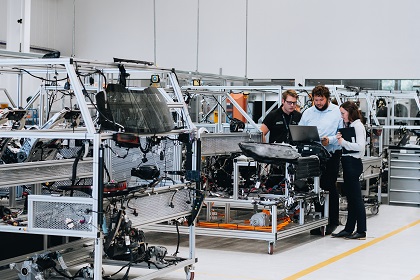
MarketandResearch.biz has posted a new report on the ‘Global Conveyor Equipment Market by Manufacturers, Regions, Type and Application, Forecast to 2025’. They report that manufacturing plants specifically are currently looking into the following technologies that might keep their supply chains in business:
- Automated Guided Vehicle Systems (AGV)
- Automated Storage & Retrieval Systems (AS/RS)
- Conveyor & Sortation Systems
- Robotic systems
Meeting the employability demands of automation
QS, a leading global education network has compiled a report entitled ‘How Artificial Intelligence is Influencing Graduate Employability’. The report encourages students to think about how artificial intelligence (AI) and machine learning (ML) may replace jobs within industries and alludes to the fact that students need to master the fundamentals of AI and ML to future proof their careers. The report points out that employers are seeing the cost-benefit of employing and utilizing technologies that utilize AI. The report reads:
“Overall, 67% of employers feel that by the year 2030 AI will indeed provide a more cost-effective alternative to highly skilled jobs, showing that almost two-thirds regard AI as a threat to the graduate labour market. “
However, most experts are confident that AI-based software systems will not replace highly skilled positions, but rather help augment the work that engineers and workers undertake within an organization. Therefore, staying abreast of the technical side of automation software and technologies is important for the technician, technologist or engineer. The ability of employees to be ready and prepared for the next generation of emerging jobs, as a consequence of automation, is the mark of a transformative engineering professional.
The industries showing immediate automation appetite
Oil and Gas company Cairn India accounts for approximately 25 per cent of India’s domestic crude oil production. India has had one of the more stringent lockdowns in the world. Cairn India went from having a mammoth 7,500 personnel on-site, to having just 1,500 personnel since the lockdown was announced.
The oil industry, in general, saw incredible swings during the global lockdowns. Not only did the price per barrel of oil stoop to a historic low, but engineers were also forced off plants. “The COVID-19 pandemic has had a profound impact on lives and livelihoods. The engineering work landscape has been rapidly evolving, and the pandemic has accelerated and changed the landscape in ways we are only beginning to understand,” says ASME Executive Director/CEO Tom Costabile. “Engineers are applying technologies including artificial intelligence, robotics, and 3D printing to help respond to the public health crisis, and also to adapt processes in many industrial sectors and transform supply chains for the future.”
Talking to the Economic Times India, the chief digital officer of Cairn, Anand Laxshmivarahan said: “In the post-COVID-19 world, the focus has shifted to cost optimization; the only place companies are willing to invest is in automation.”
The Economic Times India says Tata Steel, Ceat Tyres, Maruti, Mahindra, Toyota and Tata Motors have looked into how to continue further automating their production lines as a consequence of the pandemic and lockdowns. Human resource officers from those companies quizzed on how the pandemic was affecting them are all clear: digitisation and automation is now the name of the game. The renewed push to automate even more of the automotive sector is in line with the reports on the Global Conveyor Equipment Market forecasts.
When companies invest in new technologies, engineering professionals confront new challenges in their employment and this highlights the need for high-quality training and education in the area. While several pathways will lead to a career in industrial automation engineering, most universities only offer this specialisation as a Masters. However, EIT offers advanced diplomas, bachelors and masters specifically focussed in industrial automation. Or, for those who wish to upskill via an intensive short course, EIT’s three-month online Professional Certificate of Competency in Programmable Logic Controllers (PLCs) & SCADA Systems highlights recent developments, using case studies, and the latest application of SCADA, PLC technologies and fundamentals.
Works Cited
Bhattacharyya, Rica, and Lijee Philip. “Automation Key to Post-Pandemic Production.” The Economic Times, Economic Times, 27 Apr. 2020, economictimes.indiatimes.com/news/company/corporate-trends/automation-key-to-post-pandemic-production/articleshow/75395665.cms?from=mdr.
“Global Conveyor Equipment Market 2020 by Manufacturers, Regions, Type and Application, Forecast to 2025.” Marketandresearch.biz, www.marketandresearch.biz/report/130737/global-conveyor-equipment-market-2020-by-manufacturers-regions-type-and-application-forecast-to-2025.
Johnson Itumeleng is an industrial electrician from Botswana who recently graduated from the Engineering Institute of Technology with a 52726WA - Advanced Diploma of Electrical Engineering. He currently works for the Debswana Orapa Mine.
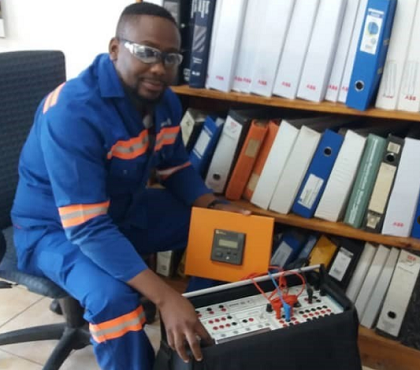 “I chose this course because I have always wanted to be an electrical engineer. My studying experience with EIT has been consistently good. EIT has a lot to offer and is very capable. I have learned a lot, and I am executing my daily work in a much more professional manner with what I have learned from EIT. I am recommending to my workmates to enroll in this course — one of my colleagues is actually already enrolled, in fact,” he said.
“I chose this course because I have always wanted to be an electrical engineer. My studying experience with EIT has been consistently good. EIT has a lot to offer and is very capable. I have learned a lot, and I am executing my daily work in a much more professional manner with what I have learned from EIT. I am recommending to my workmates to enroll in this course — one of my colleagues is actually already enrolled, in fact,” he said.
Johnson had immense respect for his grandmother as he grew up. He also had an affinity for engineering — specifically electrical engineering. With his grandmother encouraging him, and a dream to succeed in engineering, he was able to work hard and succeed at earning his advanced diploma with EIT.
“Kebatlhokile Dorothy Thatoyarona was a great inspiration and my motivator. She was my grandmother. She always believed in me and guided me throughout life until she passed in 2018. My love for engineering stemmed from my school years. I finished high school in 2003. I knew since I completed a school design project that I would like to do something with electricity,” he said.
Johnson has always been determined to figure out technological challenges. Ready and prepared to deal with technology through a more hands-on approach, Johnson started his career in engineering as an apprentice in Orapa Training Centre in 2007. The facility trains apprentices not only for Debswana mines but for other organizations across the country. Debswana is the world’s leading producer of gem diamonds.
The training facility provides their apprentices with significant on the job training in the mining sector. In 2012, after spending four years as an apprentice, he became employed by Debswana in the Power Distribution sector. He is responsible for supplying high voltage to the three mines and maintaining the HV equipment.
Acutely aware that he had to continue growing his theoretical knowledge and combine it with his ongoing practical experience, Johnson enrolled in the 52626WA - Advanced Diploma in Electrical Engineering with EIT.
Johnson says that he is gearing up to continue his academic and practical journey to becoming a fully qualified engineer. He has expressed interest in registering for the Bachelor of Science (Electrical Engineering) with EIT. By 2025, he aims to have earned that engineering title.
The Engineering Institute of Technology (EIT) is committed to encouraging women to join the engineering industry and supporting our students throughout their respective journeys.
In 2017, the World Economic Forum released reported that while approximately 20% of engineering graduates are women, only 13% of the engineering workforce is female. While the industry is still very much dominated by males, it is still worth reflecting on the work that has already been done by females to change this, one step at a time.
Australia’s first female electrical engineer, Florence Violet McKenzie, had an incredible career that was characterized by her contribution to encouraging women to become engineers, and for her wireless communication efforts in World War II.

In the early 1930’s she was the only female member of the Wireless Institute of Australia, which is where she took her electrical wiring knowledge and expanded on that by studying the chemistry of television. She joined the Women’s Engineering Society — the only society in the world, pushing for the representation of females in the engineering industry — and from there, she founded an educational initiative named the Electrical Association for Women.
When the war broke out, she used her qualifications and teaching skills to form the Women’s Emergency Signalling Corps, to help women become skilled in wireless communications, which would assist the military in the war. She and some of her trainees managed to form the Women’s Royal Australian Naval Service (WRANS) – this was the first time that women were allowed to join the navy, and the urgent need for telegraphists meant they were relied upon heavily. By the end of the war, WRANS represented 10% of the entire Royal Australian Naval Force.
By training up thousands of women in telegraphy, Florence paved the way for women to pursue careers in the Science, Technology, Engineering, and Mathematics (STEM) industries.
EIT wants to continue creating female spiritual successors of Florence Violet McKenzie in the modern engineering world. We hope to cultivate the engineering skills of school leavers and already-working engineering professionals and help elevate them into long-lasting engineering careers.
One of those ‘spiritual successors’ is EIT’s Student Ambassador for 2020, Mildred Nanono. She is a Control and Instrumentation Engineer at Eskom Uganda Limited (EUL), who completed her Master of Engineering (Industrial Automation) with us in 2018.
She said she finds pride in her work, which involves keeping the lights on for 40% of the Ugandan nation.
“I had always wanted to be part of a team, contributing to the power sector. Given the small number of ladies in the sector, I was motivated to join the male-dominated field to make my contribution toward national development,” Mildred said.
Tough times call for innovative measures
EIT has continued to deliver courses as usual throughout the COVID-19 pandemic, despite many institutions being forced to close, thanks to our revolutionary online training methodology that we have developed over the past 15 years.
With our practical online learning model, there is no reason why educating women in engineering has to cease just because of tough times — something Florence Violet McKenzie masterfully demonstrated during World War II.
EIT’s Deputy Dean, Indumathi V, is a shining example of a woman who is ceaselessly passionate about engineering education and ensuring women feel empowered enough to consider a career in the industry.
“I am a strong advocate for girls and women in engineering, also encouraged by being a mum of two young girls and a boy myself. I strongly believe that it is important for young girls from a schooling age to be aware of the various career options and study pathways available to them and to ensure they understand that they are capable of taking on technical roles and STEM fields,” she said.
If you are looking to study engineering and have identified a course you think would be perfect for growing your skills, you may be eligible for a scholarship. Women studying our higher education degrees can apply for our Women in Engineering scholarship. If successful, you will receive mentorship from one of our female engineers, plus a financial incentive. Both current and prospective students can apply for these scholarships.
The Engineering Institute of Technology will soon be rolling out a new flagship Professional Doctor of Engineering qualification for engineering professionals looking to contribute to the development of their specific engineering disciplines. We are proud to announce that Australia’s independent national quality assurance and regulatory agency for higher education, the Tertiary Education Quality and Standards Agency (TEQSA), has approved the Engineering Institute of Technology’s Professional Doctor of Engineering for delivery in 2021. EIT’s doctorate provides engineering professionals the opportunity to solve a problem or develop an improvement to an engineering challenge in their employment.
Students will soon be able to apply for the Professional Doctor of Engineering and take a leading role in the research and development of the specific industries that they are involved in - with the assurance that they will be professionally recognized as Doctors of Engineering upon completion of the program. The Engineering Institute of Technology now delivers programs for the entire academic journey of technicians, technologists, and professional engineers from short courses, diplomas, bachelor’s, and master’s degrees, through to professional doctorate-status.
 Creating innovative solutions to technological problems in society is what engineers are constantly aspiring to do. However, some engineers find themselves deeply embedded in academia and yearn to innovate and perform practical innovations in industry. The EIT Professional Doctor of Engineering (DEng) will allow engineers to be able to make original and significant contributions to the development, application, and evaluation of professional knowledge by engaging with practical problems of demonstrated importance to their employment context and the wider body of engineering and technical knowledge. Successful completion of the program will equip graduates to take a leading role in the development of research investigations into current and future problems of industrial and community concern within their area of expertise. The program will give candidates the skills and experience to act as independent researchers or group leaders for investigations of practical importance in their professional area over their professional life.
Creating innovative solutions to technological problems in society is what engineers are constantly aspiring to do. However, some engineers find themselves deeply embedded in academia and yearn to innovate and perform practical innovations in industry. The EIT Professional Doctor of Engineering (DEng) will allow engineers to be able to make original and significant contributions to the development, application, and evaluation of professional knowledge by engaging with practical problems of demonstrated importance to their employment context and the wider body of engineering and technical knowledge. Successful completion of the program will equip graduates to take a leading role in the development of research investigations into current and future problems of industrial and community concern within their area of expertise. The program will give candidates the skills and experience to act as independent researchers or group leaders for investigations of practical importance in their professional area over their professional life.
Who should apply for EIT’s Doctorate?
The Deputy Dean of the Engineering Institute of Technology, Indumathi V, says she is looking forward to seeing what kind of professionals apply for the Doctor of Engineering. Professionals with four-year bachelor’s degrees and significant work experience or a master’s degree in engineering may be eligible to apply for EIT’s Doctor of Engineering program.
“Australian and international professionals in pretty much any engineering industry can apply. If you are from construction, transportation, manufacturing, power, mining — you name it. They could even be a person who is perhaps working in an engineering consulting firm, and might be seeing a recurring engineering problem they are trying to solve,” she said.
Prospective students from countries outside of Australia, who are keen to study and ultimately work in Australia, can begin work on their Doctorate via EIT’s unique online methodology in their home country and have the option of applying to transition to an EIT campus in Perth or Melbourne.
Indumathi is currently pursuing her Ph.D. on the topic of Engineering and Education at the University of Southern Queensland. Her research work includes looking at how institutes can combine technologies to assist students and teachers in the learning environment. Her expertise in this field will be translated into the EIT Professional Doctor of Engineering delivery methodology.
Why should you apply?
EIT’s Doctor of Engineering program is unique in comparison to a traditional Doctor of Philosophy, which is particularly academic research focused. In contrast, EIT’s doctorate centers around applied research and allows students to make a significant and original contribution through innovative problem solving, engineering design, and analysis, furthering the professional practice.
Upon completion of the doctorate, the engineer will have gained skills and knowledge that will further enable them to perform technical investigation, apply their research, and develop solutions to the problems they have set out to grapple with. A Doctor of Engineering qualification will also open up new opportunities for employability within the engineering industry. It is the highest academic award in engineering, and the Doctor of Engineering gives formal recognition to engineers, enhancing their professional standing.
Another benefit of pursuing EIT’s Doctor of Engineering is the program’s cost-effectiveness. When compared with the traditional cost of a Ph.D., EIT’s solution presents a unique opportunity for passionate engineers who are looking for a new way of acquiring their ‘doctor’ status.
This program is highly recommended for engineering professionals who have a passion for engineering and want to contribute to the profession through original contribution of knowledge within the context of professional practice. It can include engineering professionals from any engineering field.
Please register your interest by
Roads are an essential part of everyday life and crucial to economic development. Transportation networks require well-maintained roads; however, the maintenance of roads is a resource-heavy job. It is a costly exercise for local governments to constantly repair roads, and therefore, the sector is primed for innovation.
 The techniques involved in the construction of roads are in flux and being revolutionized across the globe. Keeping abreast of the latest methodologies may be daunting for engineers; however, the Engineering Institute of Technology is ready and able to equip engineers with the skills they need to thrive in the industry.
The techniques involved in the construction of roads are in flux and being revolutionized across the globe. Keeping abreast of the latest methodologies may be daunting for engineers; however, the Engineering Institute of Technology is ready and able to equip engineers with the skills they need to thrive in the industry.
A technological leap in road repair
Experts predict that soon small autonomous unmanned vehicles may be dispatched to patch cracked and potholed roads. Others say the key to road construction and maintenance in the future lies in self-healing concrete, making disruptive road works a thing of the past.
Purdue University’s Lyles School of Civil Engineering has created ‘smart’ concrete. This new technology allows concrete-paved bridges and highways to alert engineers when extensive damage has occurred.
Luna Lu, an associate professor at Purdue, explains that Purdue is ‘investigating different types of highly porous, sandlike materials called internal curing agents to mix into concrete.’ When the road begins cracking, the agents absorb water and cause a chemical reaction. The reaction starts to ‘heal’ the concrete by creating a solid that seals the crack.
The university is silent on what specific elements go into their self-healing concrete, but are promising that their research is being compiled and readied for publication soon.
The university is confident that the concrete could even cut down traffic jams and the length of road closures for repairs as a result of its crack-identification capabilities. The smart concrete could “talk to the engineer,” says Lu, visually showing them when preventive maintenance is needed.
Engineering researchers are hoping that self-healing road materials will help roads last longer. The aim is to have them last up to eighty years without the need for maintenance. Getting to that point will involve a ton of hard work.

Right now, however, sustainability in road construction is becoming paramount due to the environmental impact of road construction. The protection of landscapes is now a huge consideration in the construction industry, and roads need to be constructed as greenly as possible.
Learning the fundamentals
Engineers may still be pondering the future of roads; however, one thing is for sure: engineers will always need to be proficient in the fundamentals of road construction. Technolgy around road construction is developing rapidly, so it is also vital for engineers attached to these projects to be ahead of the learning curve, by undertaking regular professional development.
At the Engineering Institute of Technology, we are delivering a three-month online professional development course in the Fundamentals of Road Construction. The course covers the basic principles and concepts used in the management, planning, design, operations, and construction of roads. It also consolidates the cutting-edge methodologies being employed by construction industries across the globe. The fundamentals you will learn, include:
- The factors involved in the planning of the roads
- How to categorize and prioritize the properties of alternative road materials.
- Earthwork operations
- How to propose drainage and pavements systems
- Roadside aspects
The course ensures that students receive both theoretical knowledge and practical experience in the construction, operability, design, and maintenance of road facilities. It covers the appropriate maintenance measures, adaptation, and improvement of roads - most importantly, how to ensure safety for motorists as well.
EIT’s Professional Certificate of Competency in Fundamentals of Road Construction includes modules on control of surface water drainage, the provision of underground drainage, the provision of safety barriers, and signs and lighting for the safe operation of the road.
Works Cited
Engineering, Interesting. “Simple Self-Healing Roads Can Last Up to 80 Years.” Interesting Engineering, Interesting Engineering, 12 Mar. 2018, interestingengineering.com/self-healing-roads-last-80-years.
Purdue News Service. “Enabling Highways and Bridges to Prevent Their Own Damage.” Purdue University News, www.purdue.edu/newsroom/releases/2020/Q2/enabling-highways-and-bridges-to-prevent-their-own-damage.html.
Hi everyone,
We will be conducting an infrastructure upgrade on EIT’s Moodle site.
What is happening?
We will be migrating our Moodle site to a new and improved server. The goal of this upgrade is to both enhance the security and flexibility of our Moodle site.
Preserving both the integrity and security of our students’ data is something we take very seriously at EIT. The new infrastructure has a range of pre-configured security features that provide industrial grade firewall protection, system alerts for malicious activity, and frequent anti-virus scans. We also have the capability now of facilitating security patches with ease; enabling us to stay up-to-date with the latest security trends, while also ensuring we can streamline our future maintenance period.
How does this impact you?
Moodle will be unavailable on the 16th of June at 1AM UTC for a period of 2 hours.
All Learning Support Officers are aware of this downtime, and all BlackBoard sessions will be rescheduled if it occurs throughout this time. If you need any materials throughout this time, then please make sure you download them from Moodle prior to this maintenance period.
If you have any additional questions then please get in touch with your LSO.
In light of the COVID-19 pandemic, the Australian Federal Government has announced a relief package, which means they are funding six-month higher education certificates in ‘priority areas’ – one of which is engineering.
We have been busy designing industry-oriented online undergraduate certificates and graduate certificates to help those already working in the engineering field, or those who want to enter the engineering field, retrain or upskill.
 For a small contribution, you will be able to earn a short qualification from EIT in the areas of electrical engineering, mechanical engineering, industrial automation engineering, and civil and structural engineering.
For a small contribution, you will be able to earn a short qualification from EIT in the areas of electrical engineering, mechanical engineering, industrial automation engineering, and civil and structural engineering.
Federal Education Minister Dan Tehan said this package was designed to give those affected by the coronavirus an opportunity to upskill or look at different career options for the future.
“We’re slashing the prices of degrees and diplomas in short courses to enable people, rather than binging on Netflix, to be able to binge on studying –areas where we need people, and we’re going to need people, as we emerge from the coronavirus pandemic,” he said.
This means that Australians can use their time in lockdown to gain new skills and knowledge in in-demand areas, so they are ready to rejoin the workforce post-coronavirus. However, you don’t need to be affected by the pandemic to take advantage of this opportunity to gain a new qualification.
Mr. Tehan said the government has encouraged education providers to develop courses in areas that will give students the required skills after the coronavirus pandemic.
“There’ll be an offering of short diploma-style certificates, and, also, an expansion of graduate certificates. So, these are six-month courses. You could either use them to reskill, or you can use them to change careers, or just to start learning.
“So, if your life’s been turned upside down because of the coronavirus, and, you think, ‘Okay, I might want to change careers,’ then this is a real opportunity, for the next six months, to take on board one of these short courses.”
These online short qualifications are known as micro-credentials and have become increasingly popular in recent years. Researchers from Edith Cowan University and Flinders University suggest this is because these short courses are able to align themselves with industry needs through collaboration and deliver targeted skills that are required in the workplace.
At EIT, we will be offering a choice of eight online qualifications supported by the Australian Government via a Commonwealth Supported Place (CSP). This means the government will pay for part of the course, while students will only have to contribute $500. Eligible students can defer their student contribution payment through FEE-HELP.
These qualifications will be delivered via our unique online delivery methodology, which allows students to connect with each other and their lecturer in real-time during the live and interactive tutorials. State of the art technologies, such as remote laboratories and simulation software, enable students to gain practical knowledge that can be immediately applied in the workplace.
These new courses will only be available to Australian/domestic students and will begin in June 2020.
The ‘future of work’ is being shaped by a powerful force; the growing adoption of online technologies and artificial intelligence in the workplace. This year has seen the world as we once knew it change rapidly, with the majority of the globe going into an unprecedented lockdown due to the COVID-19 pandemic. While it is easy (and expected) to feel anxious when there is so much uncertainty and change, there is an opportunity to upskill or skill shift in technology and leadership to meet the requirements of continuously evolving workplaces.
The COVID-19 pandemic has demanded that workplaces and education providers adapt to new technologies. These technologies have allowed people to work and study from home while maintaining consistent levels of communication and collaboration.
 The pandemic has also painted a picture of a world where automated machines increasingly replace workers so that companies can become more efficient, ensure fiscal responsibility, and maintain productivity. For those caught up in the gig economy, it has exposed a fundamental lack of job security paired with the precarious nature of work. While governments, companies, and employees have been preparing for the disruption of the Fourth Industrial Revolution for some time, this pandemic has likely accelerated advances in technology beyond what we expected.
The pandemic has also painted a picture of a world where automated machines increasingly replace workers so that companies can become more efficient, ensure fiscal responsibility, and maintain productivity. For those caught up in the gig economy, it has exposed a fundamental lack of job security paired with the precarious nature of work. While governments, companies, and employees have been preparing for the disruption of the Fourth Industrial Revolution for some time, this pandemic has likely accelerated advances in technology beyond what we expected.
By recognizing these challenges to the labor market, we now have an opportunity to look at the bigger picture and lay the foundations for a more resilient future, according to the World Economic Forum.
This acceleration in digitization and automation means upskilling and reskilling is necessary to ensure employability in ever-evolving workplaces. Key skills in these areas consist of coding and programming, machine learning and artificial intelligence, industrial data communications, and instrumentation, automation and process control.
At the Engineering Institute of Technology (EIT), we believe in instilling our students with cutting-edge skills that the industry demands. These skills are taught via our unique online delivery methodology, which allows students to connect with each other and their lecturer in real-time during the live and interactive webinars. State of the art technologies, such as remote laboratories and simulation software, enable students to gain practical knowledge that can be immediately applied in the workplace. While we offer formal qualifications from diplomas and advanced diplomas, through to bachelor’s and master’s degrees, we also offer three month short courses in micro-skills to help engineers future-proof themselves as the industry continues to evolve.
Being able to problem-solve in a digitized world is becoming increasingly important. Through EIT, engineers and technicians can study python programming to help them solve engineering problems, write automation scripts, and manipulate and analyze big-data.
As businesses become increasingly automated, engineers need to have a thorough understanding of the technologies used to achieve this. Industrial networking and industrial data communications systems are essential to keeping electronic and digital data transferring between devices. Therefore, it is crucial that those who work with these systems understand the components and can identify, prevent, and troubleshoot any problems. Likewise, engineers who work with systems that are becoming increasingly automated must have practical knowledge regarding the selection, installation, and commissioning of industrial instrumentation and control valves. It is also important that they have a fundamental understanding of PLCs and SCADA systems. EIT offers short courses in these areas that allow you to upskill in a practical way, so you can immediately implement what you have learned, to become more efficient at your job.
It is not only digital skills that need to be enhanced, though; it is equally important for engineers to hone their ‘human skills.
Throughout this pandemic, employers have had to work harder to show support and leadership. However, this crisis has given them the opportunity to consider their employees’ needs on a holistic level, to keep them engaged and motivated physically, mentally, and emotionally. Leadership has become increasingly important as processes have had to become streamlined to facilitate quick decision making, new technologies have been quickly introduced, and teams have had to find new ways to collaborate despite being physically apart.
According to Forbes, times like these expose true leaders as they are forced to step up and perform beyond their usual duties.
“Throughout a crisis, leadership is more important than ever. It is also clear which leadership behaviors are most effective. In the toughest times, the leaders who excel are those who communicate clearly, stay calm and strong, demonstrate empathy, think long-term and take appropriate decisive action. It is likely these difficult times will filter out leaders who are less stellar.”
As companies continue to implement new technologies and automate certain practices post-pandemic, employers and managers will be expected to continue demonstrating strong leadership, to maintain the trust and faith of their teams. EIT has created a three-month online course in Project Management for Engineers & Technicians, to help engineers lead their teams effectively and efficiently manage projects.
Now is the time to look towards our futures and consider where our careers may take us.
As a passionate educator, EIT’s Dean, Dr Steve Mackay, never underestimates the benefits of a good quality education. When a career path and an individual are aligned he knows the sky is the limit. Engineering and technology are the focus of EIT, but so too are those who yearn to work in a field of endeavour that inspires and drives them every day.
This is the story of a young South African man who, with has his heart set on farming, is achieving his dream. Asanda Mnguni is the one with the vision, but he is being supported by his indomitable mother, Nomsa (Gloria) Mkhwanazi, a gifted farmer, Ms Gitti Kraupner, and the Engineering Institute of Technology.

Asanda is 21 years old and studying away from home, but during college holidays he lives with Gloria, a single parent, a house keeper and part-time carer of the frail and elderly. They live at the foot of the magnificent Drakensberg Mountains, in Himeville - a tiny village near Underberg. Whilst the region is known for tourism, it is also known for its farming communities.
Himeville also happens to be where Steve Mackay’s wife grew up. Asanda explains, “Steve and Edwina started supporting my mother when I was still a child because of our poor living conditions. The year was 2006, and my mother was unemployed at the time. We have been receiving their support ever since.”
Building an agricultural future
Asanda is in his third year of a Diploma of Agricultural Management at Cedara Agricultural College. He says his future in agriculture looks bright because he is receiving support from local commercial farmers who are allowing him to gain practical experience on their farms and it is helping him gain the necessary skills needed within the farming sector.
“Growing up in a farming community made me consider agriculture as a possible career choice. I may be one of the first black farmers within my community once I have completed my studies,” Asanda says proudly.
During South Africa’s Covd-19 lock-down, Asanda has been working on an Aquaponics project on Gitti Kraupner’s farm in Himeville. The Aquaponics project is a new addition to the farm – the farm typically specializes in cattle breeding.
Aquaponics is a system of aquaculture in which the waste produced by farmed fish, or other aquatic creatures, supplies the nutrients for plants grown hydroponically (without soil) and in its turn purifies the water.
In drought prone regions many South African farmers are beginning to view aquaponics as a viable farming alternative and it is being considered a means to producing food for impoverished communities. Asanda notes that an aquaponic ‘farm’ can be started in the smallest of backyards and retailers have the necessary equipment for a start-up.
About the project he is involved with, Asanda explains, “We have constructed the whole aquaponic system from scratch. Advantages of this system include reduced water wastage, increased production per square meter and an organic way to produce food when compared with traditional farming methods. This approach will help feed the growing population and meet the future demand for food.”
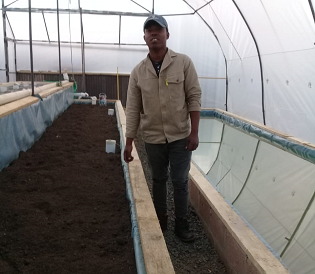
Asanda is passionate about the future of agriculture in South Africa and wants to see a turn-around in the economy where 29% of South Africa’s population are unemployed.
Asanda concludes, “In the next 5 to 10 years I really want to see myself on my own farm implementing all the knowledge I have learned while studying, and the skills I’ve obtained from farm experiences. I really hope to inspire the youth - not to think of agriculture as a rudimentary job in society, but to understand the importance of farming, especially in rural areas where most of the youth can grow their own wealth without having to search for it in cities where employment can be a challenge.”
All of us at EIT are very proud of Asanda. He is dedicated to his studies and has taken advantage of the practical farming experiences offered to him.
Steve Mackay remains in awe of EIT students and alumni who draw on their education and entrepreneurial skill to support their communities. It is this sense of social responsibility which inspires EIT to do the same.
It was clear that all Asanda needed - to make his way in the world - was determination, an opportunity to demonstrate and hone his growing skill, and a little support. We wish him well as he works towards completing his qualification and becoming a fully-fledged farmer in South Africa.
Aaron Giovenco is an electro-technical specialist who works in the maritime and offshore oil and gas industries. He says our 52708WA - Advanced Diploma of Industrial Automation developed both his theoretical and practical knowledge in the automation space, which will help him to further his career.
He began his career as an electrician after seeking employment opportunities in Perth, Western Australia, due to its mining boom. While studying his apprenticeship, he realized he was interested in engineering.
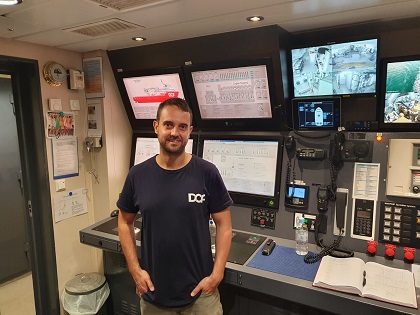
“Back in 2008, when pursuing my electrical apprenticeship, I found the theoretical side interesting and enjoyed learning it,” he said.
“This passion has continued to evolve over my career. I enjoy designing and coming up with solutions, which is why I’ve decided to pursue a career in the engineering industry, and automation and control engineering has great future job growth potential.”
Once he became qualified, Aaron spent a couple of years working in a myriad of different environments. One thing he says he noticed was how much technology had bled into the sector and fundamentally transformed it. After he took an opportunity to lead a team on a coal seam gas project in Queensland, he realized he wanted to pursue a career in the engineering industry.
He currently works as an electro-technical officer for a marine operations management company on Shell’s Prelude FLNG Project. The job sees him working with a team of people within the ship’s engineering department, and his responsibilities include carrying out electrical and electronic maintenance, repairs, diagnosis, installations, and testing.
“A key part of my role is maintaining high integrity and availability of key vessel systems such as power generation, VFDs with associated thrusters, and automation systems such as dynamic positioning. When breakdowns occur, I attempt to fault find and come up with a solution. However, sometimes this is not possible due to parts, which is why the redundant architecture is important to keep maintained.”
Throughout his career, Aaron has had to familiarize himself with automation technologies and complex instrumentation. He says that the trend of newly introduced automation technologies will likely continue exponentially into the future. Therefore, he decided to complete an advanced diploma through EIT that would encapsulate a broader scope of the industry in the one course.
“Studying the 52708WA - Advanced Diploma of Industrial Automation has enabled me to simultaneously strengthen theoretical knowledge within my present occupation, while also upskilling my qualifications for a future career. I chose Industrial Automation specifically because, in my opinion, it offered a broader range of subjects than a conventional electrical or instrumentation course and also because the qualification is formally recognized by Engineers Australia and internationally through the Dublin Accord.”
Aaron is planning to continue his academic and working journey with further studies.
“I will continue working for my current employer as the job suits me at this stage of my life. I’m also planning to study further - I recently enrolled for the Bachelor of Science (Industrial Automation) with EIT.”
It is said that iron sharpens iron. At the Engineering Institute of Technology (EIT), that statement rings true every day. There is an ecosystem of managers, learning support officers, and course advisors who work in tandem to ensure students enrolled in our programs are on their way to achieving their academic and career goals.
The South African office has had to roll with the punches of the strict lockdown regulations imposed as a consequence of the COVID-19 pandemic.
Sisipho Phakamisa, an EIT Learning Support Officer, says the person who has been keeping her on-track amidst the lockdown is EIT Africa’s International Education Manager and South African Office Manager David Gadjus.
“He has proven to be a proactive leader, as well as very supportive,” she said.
“He engages a lot with the team, and he always jumps at the opportunity to help. The lockdowns took us all by surprise, and he has done a great job of unifying us in what would otherwise be a very chaotic time.”
Anele Fihla is a Course Advisor in EIT’s South African office. Her daily responsibilities include handling enquiries from prospective students, and explaining to them what EIT’s transformative online and campus-based engineering courses entail.

Once the students have registered for courses, Anele helps maintain the growing EIT student database. She is also currently responsible for the Health and Safety Department in the Johannesburg office. Anele says that it is the internal synergy within EIT’s offices that produces the cohesive, well-oiled machine the students have come to know and love. Anele says that in this time of lockdown in South Africa, it is the managers inside the institution who show her how to stay level-headed. Anele says the person who has helped her deal with some of the tougher moments during lockdown has been Regional Manager of the Southern African branch of EIT, Cheryl Segal.
“I have learned a thing or two from her through observing her. The most important nugget of wisdom she has imparted to me is: focus on one thing at a time. When she spoke to me about this, it made me understand why she is so level-headed. She seems to block out a lot of the noise and prioritizes the goal at hand. Personally, I feel this is an important attribute to have during a workday. It is important for your mental health,” said Anele.
Meanwhile, David has coordinated an entirely virtual office remotely and ensure all the staff members are on track to achieving the organizational goals. He says one of the more effective ways of keeping everyone relaxed during the anxiety-inducing lockdowns is to have a catch-up meeting with the staff on a Friday that doesn’t involve any work talk.
“I have been amazed at the resilience of the South African staff,” he said.
“They have managed to keep the office running smoothly despite the restrictive lockdown in the country. South Africans, in particular, are getting through this tough time with their amazing sense of humor and their dedicated work ethic as well.”
With the influx of enquiries, the South African team is working hard to get the new students registered and studying via our unique online delivery methodology. South African engineers-in-waiting are seeking out online programs due to the closure of university campuses around the country. School leavers are particularly looking into alternatives due to the disruption of the academic year.
Anele says she is ensuring that she speaks to prospective students as calmly and sensibly as possible. She says she is cognizant that this is a scary time for those who are trying to gain skills in the industry and contribute to their communities as much as they can. Students of EIT— and the prospective ones considering signing up for a course soon — can breathe a sigh of relief knowing the course advisors and learning support officers are ready to help them take control of their futures and help them study online without disruption.
Hamis Mahushi is a Tanzanian born instrumentation and control technician and alumnus of the Engineering Institute of Technology (EIT). Since graduating from our 52708WA - Advanced Diploma of Industrial Automation, he has furthered his career in the mining automation industry and taken on a leadership role. He currently works at North Mara Gold Mine, a few kilometers from the Serengeti National Park in Tanzania.
His engineering journey started in 2009 — which Hamis refers to as “the year of my life” — when he enroled in an Ordinary Diploma of Electrical Engineering. In 2012, he began working at North Mara Gold Mine, which was controlled by a company named African Barrick Gold at the time. In 2014, the company changed its name to Acacia Mining.
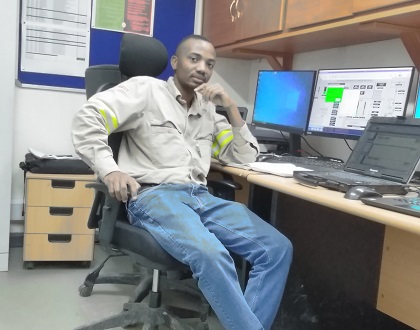
Under Acacia Mining, he got the opportunity to work as the Instrumentation Mechanician. A superintendent at the mine noticed Hamis’ thirst for knowledge and encouraged him to explore the automation side of the industry. Soon, Hamis was doing Programmable Logic Controller (PLC) training in South Africa. The bug had bitten, and Hamis wanted to know more.
He familiarized himself with the tools of the automation trade; Rockwell Automation products like the Rslogix 5000 and the FactoryTalk View ME and Panelview Plus. He was learning Rslogix function block programming and underwent training for SCADA on the software and hardware levels from Schneider Electric South Africa.
In 2015, he began an apprenticeship while working, and by 2016, he passed his instrument trade test. From that day forward, he could call himself a fully equipped artisan.
The passing of the trade test was wholly positive for Hamis. He was promoted to the role of Instrumentation and Control Technician. As he was settling into the job, he saw that it served him with a whole new set of complex challenges.
“I found out that I needed more knowledge that matched our new world of fast-growing technologies. I started looking for colleges on the internet, but I had a hard time believing I would find an online engineering course.”
In 2018, still on the search to expand his skills set, he stumbled upon EIT. He researched the options we had on offer, knowing he wanted to find one that would equip him for the future of the engineering industry. Finally, he found the one he was looking for: the 52708WA - Advanced Diploma of Industrial Automation.
“I had almost six years of experience in the mining industry — especially on the gold plant and water treatment plant — before I started studying with EIT. The Industrial Automation qualification covered everything within the plant — it just like special training for our plants. From instrumentation designs, electrical and mechanical problems, and industrial network and safety concerns”.
Hamis is one of the many examples of hardworking engineering professionals who are, as they continue to amass work experience, growing their skills with education and training.
Now, Hamis is the Acting Instrumentation and Control Supervisor at North Mara Gold Mine. He leads a team of four instrumentation technicians. His other daily responsibilities include the preparation of all instrumentation at the mine, supervising new instrumentation installations, and the ordering of new instruments. He masterfully troubleshoots PLC and SCADA systems and installs and troubleshoots VSD and high voltage instrumentation.
“I can see how happy my employers are when I am performing my tasks. This gives me a picture of my future, and my future will be great. My engineering career is expanding as I arm myself with more skills and knowledge.”
Hamis completed the course with EIT in December 2019 but does not want to slow down.
“I am still thirsty for knowledge. I wish one day to do a Bachelor of Science (Industrial Automation Engineering) with EIT. I encourage all people to open the EIT website and pursue their futures in engineering.”
Australia is well-known for its beautiful beaches, with over one million tourists making their way to the beach each year. From national surf competitions to school swimming lessons, Australian beach culture is a huge part of the country’s national identity.
However, there is one significant challenge that comes with enjoying over 20,000 kilometers of coastline, and that is patrolling it. Due to not only its size but also the sheer amount of potential dangers lurking beneath the waters surface, keeping Australia’s majestic coastlines safe is a logistical nightmare.
But a world-first in drone technology may be the potential solution.
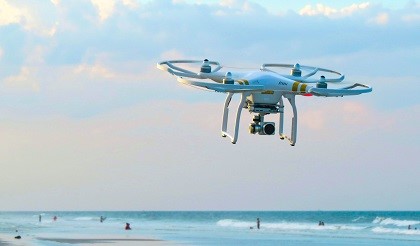
Founded in 2015, Australian company ‘The Ripper Group’ develops search and rescue drones that can monitor beaches and deploy emergency care packages to people in need. With features including being able to alert lifeguards to people who need saving to being able to spot incoming predators, their drones are already being used across the country to help keep Australian beaches safe.
Sponsored by Westpac, the ‘The Little Ripper Lifesaver’ project represents the future in shoreline safety, being able to identity and respond to incidents beyond the human eye. In January of 2018, the lifesaving drone rescued two teenage boys off the coast of Lennox Head in New South Wales. Controlled by lifesavers onshore, the drone was able to be sent to the boys with an inflatable rescue pod attached.
John Barilaro, the state's deputy premier, praised the rescue as historic. "Never before has a drone fitted with a flotation device been used to rescue swimmers like this," he said.
However, The Little Ripper Lifesaver doesn’t only save struggling swimmers. The groundbreaking drones are now equipped with an Artificial Intelligence based system that can detect a variety of marine threats such as sharks and crocodiles. With a proven accuracy of 90%, the drones can identify possible threats and relay this information to emergency services, beach lifeguards and endangered swimmers.
“This is a great example of how an AI application can help humans, as it has significantly higher rates of visual accuracy in shark detection than people. The drone will certainly help us to improve detection rates and to maintain safer conditions for those in the water,” says Dr Nabin Sharma from the UTS Centre for Artificial Intelligence.
Anyone who wishes to fly a surf lifesaving drone is simply required to do a two-day course, making it easy for surf lifesavers across the country to get involved in the program. This lifesaving combination of AI technology and mechanical engineering is a leading example of how technology can unlock opportunities in supposedly unrelated fields, enhancing the human experience as well as unlocking new job opportunities.
Currently, the drones are also being used in partnership with Chinese UAV giant DJI to help combat COVID-19. The drones can assist in two key areas, being aerial spray disinfection and crowd control.
“Through environmentally friendly active disinfectant agents we can neutralize the Coronavirus in public places on surfaces in places like playgrounds, malls, public gyms, public transport areas, sporting arenas, schools, universities, hospitals, child-care centers, aged-care facilities, shopping centers, supermarkets, factories and warehouses,” said CEO of The Ripper Group, Ben Trollope.
Mr. Trollope also explained how the drone could help authorities in dispersing crowds to further enforce social distancing conditions.
“Using drones protects the lifeguards and police by allowing safe social distancing and does the job quickly and efficiently. This will protect first responders and front-line personnel,” he said.
Works Cited
Ballantyne, Kreisha. “Drones Watch over Beaches.” Flight Safety Australia, 10 Feb. 2020, www.flightsafetyaustralia.com/2020/02/drones-watch-over-beaches/.
Spires, Josh, et al. “Drones to Fly above Australia's Beaches This Summer.” DroneDJ, 7 Feb. 2020, dronedj.com/2020/02/07/drones-fly-above-australia-beaches-summer/.
Dr Arti Siddhpura is one of EIT’s on-campus lecturers and is a decorated academic, holding a Doctor of Philosophy in Mechanical Engineering from the University of Western Australia.
Dr Siddhpura’s engineering journey began in 1996 at the Government Polytechnic University in India, where she earned in Diploma in Mechanical Engineering. In 1996, she enrolled for her Bachelor’s Degree in Mechanical Engineering at Sardar Patel University, continuing on to earn her Master’s Degree in Mechanical Engineering (Machine Design) by 2004.
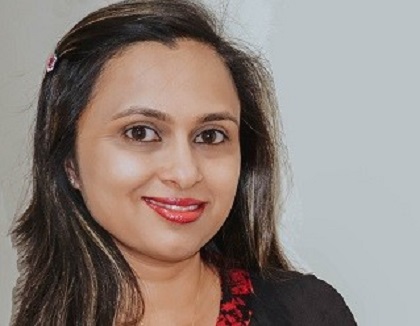
In 2008, Dr Siddhpura made the move from India to Australia, working as a casual academic at the University of New South Wales. However, by March of 2009, she has earned a position as a Research Scholar at the University of Western Australia. It was there that she began work on her Ph.D. in Mechanical Engineering, graduating in 2013. Her research has now been recognized internationally and has been published in several reputable peer reviewed journals.
Dr Siddhpura says her passion to succeed in the engineering world was all thanks to her father, who made an indelible imprint on her life. She now pursues her work with a desire to impart her experience and knowledge on others in the world, helping lead them on the path to a rewarding career in the field of engineering.
“My father sparked my interest in machines and tools as I saw him working on all different DIY projects during his spare time while growing up. After accomplishing a few engineering degrees leading to a Ph.D. in Engineering, mechanical engineering became my passion. I wanted to induce the same interest in others. The only way to do so is through engineering education and training. Hence, I ended up in the field of engineering training and education.”
After several lecturing and researcher positions in Western Australia, Arti joined EIT as an on-campus lecturer in 2019. She now spends her days at our Perth campus molding the next generation of future engineers.
“On a day-to-day basis, my lecturing responsibilities include preparations, lecture recordings, live delivery of tutorial sessions, creating assessments, marking assessments in addition to thinking and coming up with all different ideas to help students understand various engineering concepts,” she explained.
“I am also involved in the review and revision of various higher-education and VET courses and their contents. I coordinate orientation sessions before the semesters begin and lecturer training sessions throughout the year. I am heavily involved in research and scholarship activities and I have published and presented research articles in international conferences around the world.”
Dr Siddhpura says she wants more girls to be introduced into the engineering world at a young age so they can shatter stereotypes and become global leaders in STEM later on in their careers. In turn, she says, women can become role models for others. She encourages women to chase their PhD dreams:
“Earning a Ph.D. in Mechanical Engineering field was the most fulfilling goal of my life as it provided me global exposure while exploring the depth of the subject area and reaching some milestone peaks. Mechanical Engineering is an evergreen branch of engineering, without which nothing can be manufactured.”
“All the machines (from sewing machines to earth moving machines), transport vehicles (cars, ships, planes, and spacecraft) and even all the machines/components used by other engineering streams like electrical/electronic/civil engineering is made by Mechanical Engineers!”
Dr Siddhpura never felt that anything in her career felt too daunting. She never let the stereotypes of the engineering industry get to her and is a shining example of a woman who took the engineering industry by the horns. She is happy to report her personal growth and the institute’s growth since she has joined EIT:
“Personally, I feel that I am growing exponentially with ever-growing new courses at EIT. Each semester since I joined full time, I have been developing and teaching at least one brand new subject, which is a challenging yet rewarding endeavor. EIT has been undergoing a steep trajectory of growth in the last year and is developing heaps of new higher-education courses.”
She notes her excitement for the launch of EIT’s Masters courses in Mechanical Engineering, Civil and Structural, and Electrical Engineering.
The threat of the coronavirus pandemic has sent most of the world into lockdown. As a result, many of us are relying on the Internet to stay connected. As schools and workplaces continue to encourage working from home, an increasing amount of sensitive and personal data is making its way online, meaning now is the time to make sure both you and your computer are keeping safe.
Due to the high Internet usage across the globe, Internet hackers are increasingly able to exploit networks during this time of crisis. Ranging from spreading false information online to sending fake pandemic warnings directly to your inbox, scammers and hackers are embracing a whole new toolbox of possibilities.

Multinational cybersecurity and anti-virus provider Kaspersky, recently reported that on 12 March 2020, Australia saw 248,864 network attacks or data breaches. This is an increase of 284% when compared to just four days earlier on 8 March, where 64,690 attacks were reported.
With digital communications now more important than ever for the continuation of company operations across the globe, hackers are ready to see what network breaches they can exact on the unsuspecting digital public.
Key websites that inform the public have already become a focus. Worldometers.info — which many people use for updates on coronavirus statistics — was hit with what the owners of the site called a ‘malicious act.’
The US Department of Health and Human Services website was also a target of a denial of service attack. Thus, information the public depended on was momentarily disrupted. Social engineering cyber-attacks are occurring too. Email malware was recently being sent around disguised as important information on COVID-19 from official health agencies. Unsuspecting people opened what they thought was useful information regarding the coronavirus pandemic and instead had their personal data stolen.
Hackers are on the lookout to see how they can profit off of a crisis and swindle companies and people out of their data. And it is clear to see that they will try every avenue — no matter how big or how small — to try and garner some profits out of this crisis and sow societal discord.
How to fight back and how to help
The World Economic Forum has a good 3-step system to ensure you stay safe online during this time. Algirde Pipikaite, a Project Lead in Governance and Policy at the WEF, and Nicholas Davis, a Visiting Professor in Cybersecurity at the UCL Department of Science, Technology, Engineering and Public Policy write:
1. Step up your cyber hygiene standards: Check that you have a long, complex router password for your home wifi and that system firewalls are active on your router. Ensure you’re not reusing passwords across the web (a password manager is a great investment) and use a reliable VPN for internet access wherever possible.
2. Be extra vigilant on verification: Be far more careful than usual when installing software and giving out personal information. Don’t click on links from email. When signing up to new services, verify the source of every URL and ensure the programmes or apps you install are the original versions from a trusted source. Digital viruses spread much like physical ones; your potential mistakes online could very well contaminate others in your organization, an address book or the wider community.
Organizations are encouraging their workers to activate two-factor authentication on their work systems that they are logging into from home. This forces a user to put their password in, and give a second layer of authentication before being let in to their employers’ system. This gives a company peace of mind, knowing that no bad actors are logging into their systems and stealing any data - especially while many are working from home.
3. Just as you pay attention to trusted sources of data on the spread and impact of COVID-19, be sure to update your system software and applications regularly to patch any weaknesses that may be exploited. If at any stage you feel that the advice you’re being given sounds bizarre - whether the virus threat is offline or digital - search the Internet to see whether others have similar concerns and look for a well-known site that can help verify the legitimacy of the information.
Seemingly, the world’s preparedness for real viruses and digital viruses is being tested during this coronavirus pandemic. The lessons learned during this time will put the world of engineering in good stead in the future. The protection of key resources and infrastructure underpinned by developed cybersecurity strategy will now forever be of vital importance.
Works Cited
“Live Coronavirus Updates: US and Global News on COVID-19.” NBCNews.com, NBCUniversal News Group, 26 March. 2020, www.nbcnews.com/health/health-news/live-blog/coronavirus-updates-senate-white-house-reach-deal-2-trillion-stimulus-n1169196/ncrd1169696#liveBlogHeader.
Pipikaite, Algirde, et al. “Coronavirus Pandemic: Why Cybersecurity Matters.” World Economic Forum, www.weforum.org/agenda/2020/03/coronavirus-pandemic-cybersecurity/.
Shepard Ngoni realized he needed to learn more about automation due to advances in technology that were affecting his workplace. After completing his 52708WA - Advanced Diploma of Industrial Automation, his newfound knowledge gave him the confidence to open his own automotive engineering workshop, plus a company that specializes in automation.
Since graduating from EIT two years, Zimbabwean born Shepard has been a member of our esteemed alumni community. However, his journey with engineering education, which started when he was in high school, is far from over.
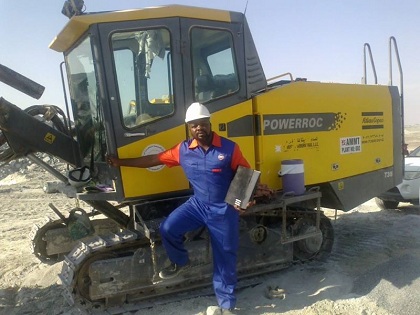
“As a high school student, I always admired the field of engineering as I was good in the fields of science subjects. From high school, I went straight into the field of automotive engineering as an apprentice with a national bus company, doing my theoretical studies with a polytechnic college in Harare.”
His automotive engineering studies took him four years to complete and included a lot of practical hands-on work, coupled with a theoretical research component. However, after completing his apprenticeship, he decided he wanted to continue learning. So, he enrolled in a diploma in motor vehicle technology.
At the same time, he worked as a diesel mechanic before deciding to move to South Africa from Zimbabwe. Once he arrived in South Africa, he worked in various companies, including Sandvik, Anglo American, and Lonmin Mines.
“I then decided to get out of Africa to seek greener pastures. That’s when I went to work in the United Arab Emirates. I worked as a drill rig technician for Sandvik, specializing in surface drill rigs made by Tamrock. During this time, I realized that the industry was swiftly shifting from being mechanical to being a more automated kind of industry. I felt I needed to bridge that gap as soon as possible.”
He subsequently enrolled for the 52708WA - Advanced Diploma of Industrial Automation with the Engineering Institute of Technology (EIT). He believed that the modules EIT offered him were in-line with what he thought he lacked in his career. During this time, he made his way back to South Africa, working as a maintenance engineer with a transformer manufacturing company.
“The studies made my work much easier and helped me to understand the design and architecture of all kinds of machines, including motor vehicle process and system design. The qualification I got from EIT enables me to be registered as an engineer with the Engineering Council of South Africa.”
Shepard says that the impact his advanced diploma has made on his career is huge, having given him the confidence to open an automotive engineering workshop that specializes in German-engineered vehicles. On top of that, he has also started a company that specializes in automation. His daily responsibilities include process analysis, troubleshooting, job allocations, and supervision.
He is looking forward to passing the baton to the next generation and training them up so they can also be ready for the kinds of engineering work of the future.
However, Shepard is still broadening his skills and knowledge — he is currently studying for a Bachelor of Science (Industrial Automation Engineering) with EIT. He plans to continue studying until he has achieved his Ph.D. By then, he believes he would have mastered this new world of automation in the engineering industry. We are proud to have him on our alumni list and wish him well for his future endeavors.
In the world of education and training, stereotypes can create negative perceptions around particular lines of study or work. The Science, Technology, Engineering, Mathematics (STEM) fields are rife with stereotypes that can dissuade young people from taking an interest in these industries, even though these jobs are becoming increasingly essential.
With the rise of technology and automation, engineering careers are becoming more diverse and more applicable across a variety of industries. Therefore, simplistic and generalized views of who engineers are and what the engineering world entails are damaging to the perception of the industry — as well as being simply untrue.

One area that engineering has expanded into is the healthcare industry. Biomedical engineering is bridging the gap between these two fields, by using technology to create, maintain, repair, and operate essential medical equipment.
Kym Rykers, a board member at the Australasian College of Physical Scientists and Engineers in Medicine in 2016, compiled a study named ‘The impact of diversity, bias and stereotype: expanding the Medical Physics and Engineering STEM workforce.’
She writes: “The demand for individuals with a science and maths based education is growing worldwide with predictions that over 20% of all future occupations will require at least a basic degree with a maths and science major. The diversity of jobs is increasing with new occupations also being created; with each year, there will be greater competition to persuade talented people to take up ACPSEM (Medical Physics and Engineering) supported careers.”
However, Rykers points out that some educators in the schooling sector are still too slow in reforming to prevent the phenomenon known as the ‘engineering spiral of death.’ This occurs when a student loses interest in engineering before high school and cannot recover the love for STEM - which potentially hurts their future employment prospects. Teachers have an immense challenge ahead of them as technology continually demands more and more fired up graduates who are ready to tackle the complex tasks that the future is presenting.
The situation is even more dire for women. Over the past decade, the industry has pushed to include more women in both entry and senior positions. Diversifying these traditionally male-dominated workplaces is one way of undoing age-old stereotypes that have characterized some industries. However, Rykers states that girls need to be included and encouraged to participate in the STEM fields from a much younger age.
“The reasons behind the low numbers of girls and women taking up careers based on science and maths is due to a host of factors which start impacting participation in primary school. Numbers drop further as women progress through to university and move into employment. This attrition means a significant cohort of talented women are lost to the science community, and it is a loss we can ill afford. To meet the continued need, it is imperative to address this loss.”
At the Engineering Institute of Technology (EIT), a number of our Course Coordinators and lecturers are female engineers. Our Deputy Dean Indumati V recently gave us her views on the issue of attracting early interest in the pre-schooling years of girls.
“Education is the foundation to a better society. Engineering is the field that is a pillar in providing economic, environmental, health, and security benefits to society. I am a strong advocate for girls and women in STEM,” she said.
“I am encouraged by being a mum of two young girls and a boy myself. It is important that girls are aware of any capabilities that they need to develop from a young age to nurture their interest in the field. I have run some successful initiatives and actively participate in events that promote girls in STEM.”
In order to keep moving forward and continue attracting people with a broad range of personality types, interests, and backgrounds into the STEM field, work still needs to be done. If, from a young age, all students are encouraged to feel positive about their prospective futures in engineering, many of the false generalizations will fall away. With how varied the engineering field is becoming, employment opportunities in the sector are still being established. There has never been a better time to study engineering.
The Engineering Institute of Technology (EIT) has been providing high quality live, interactive online education and training for over 15 years. EIT’s offerings span the two education sectors, from vocational diplomas through to bachelor’s and master’s degrees in engineering. These qualifications are accredited by the Australian Government, and some of these programs are also recognized under three international engineering accords. EIT also offers practical professional development short courses to help engineering professionals gain specialist skills. At any one time, EIT has approximately 2000 students and reaches them in over 150 countries.
This wisdom, synthesized into six truisms for driving excellence in online education, can be applied to all areas of education and training, not just to students in STEM.

1. Go back to basics to engage remote learners
Teachers must use strategies to increase their presence in the virtual classroom and ensure the learning environment is dynamic and engaging. This should include a warm welcome, an introduction (using a webcam), strong interaction, and concluding each session on a high note. These simple strategies have been measured and do improve student satisfaction and learning outcomes.
To maintain engagement throughout the class, teachers must build high levels of interactivity into each session. They should consider including all the options: learner-teacher, learner-learner, learner-content, learner-interface (such as with a computer) and learner-individual (time out with the student doing their ‘own thing’).
To overcome the psychological and physical distance between the learners and the teacher, immediacy is the key. A teacher should field and drive questions, use student names, provide feedback instantly and allow the odd digression into issues of personal interest.
2. Inflexible is better
Synchronous online learning via web-conferencing creates a ‘classroom’ in which students and the teacher gather in real-time. EIT’s unique online delivery methodology makes live and interactive tutorials, an international pool of expert lecturers, dedicated learning support officers, and state-of-the-art technologies such as hands-on workshops, remote laboratories, and simulation software.
As a model of online learning, it is less flexible, but the benefits outweigh this limitation. It ensures students remain engaged in the learning process, it facilitates interaction and questions, it connects remote learners with each other, and it reduces the notorious rates of attrition evident in asynchronous online courses. Therefore, students are encouraged to advance their technical knowledge and remain engaged in their studies while forming global networks and balancing life and work commitments.
3. Go mobile
The Internet of Things has revolutionized many things, including mobile learning for engineers and scientists. We once had a student attending a session on the train between London and Glasgow, while his teacher presented between the vines in the Swan Valley, during a staff Christmas lunch!
There are many ways in which a phone or mobile device becomes your learning tool; it can be used:
• For communication.
• For assessment.
• For reading data in the environment.
• For undertaking written assignments.
• For social networking.
• For the collection of data.
• For simulation.
• For recording lab experiments (with the camera).
• As a remote control.
4. Virtually ‘physical’ is best with remote online labs
Experiential learning — or hands-on education — is one of the most optimal ways of gaining engineering expertise. Therefore, online learning must accommodate it. The ongoing virtualization of instruments (such as oscilloscopes and signal generators that are controlled and viewed from PCs or tablets) is the impetus for using remote labs. For example, it is common for mining trucks and plant equipment to be controlled remotely; this illustrates that the virtualization of work and equipment is growing apace.
EIT’s remote labs feature physical equipment and sensors equivalent to the traditional university engineering lab. The practicals are interactive, controllable, variable, and viewable over webcams in real-time, with examples including; data communication and protocols, scientific instrumentation, physical experimentation, the control and observation of circuits, systems and machinery, and robotic automation. Students can see the immediate results of their experimentations.
Similarly, EIT’s virtual labs consist of simulation software for a multitude of engineering applications, including modelling and analysis, science education, programming, power network design, construct models, design and drafting, project management, industrial process control, and virtual plant field operations.
Some traditional teachers of engineering remain sceptical; they suggest that remote labs lack authentic, hands-on work. Despite this, learners find a well-constructed remote lab (with a simple interface) useful and equivalent to that of a traditional lab.
EIT Master of Engineering (Industrial Automation) graduate Mildred Nanono found this to be the case.
“EIT’s use of state-of-the-art technology was very, very instrumental and very beneficial. The simulations felt real. It felt like I was physically in the lab.”
Here are some pointers to constructing successful remote labs:
• Build them with a clear understanding that there will be multiple users operating the labs remotely. Using this as a guiding principle will ensure operating glitches are avoided later.
• Employ a scheduling system for the lab users - this can assist with system overload.
• Reduce system response times – they should remain below 150 milliseconds.
• Aim for ‘reality’ - with an easy-to-use graphical user interface.
• Use good lighting.
• Ensure teachers are well-trained and supportive.
• Encourage students to reuse labs to improve their results.
• Use lab work as part of a student’s final grade.
Here are some design principles for the Graphical User Interface (GUI) for remote labs:
• Keep it simple and intuitive.
• Aim for authenticity.
• Ensure multiple users can work together.
• Enable a student to interface with a standard computer (preferably within a browser) with minimal software add-ons.
• Ensure the GUI displays key information swiftly.
• Use plain English.
• Have a quick exit option from unwanted menu selections.
• Standardize interfaces and make them consistent.
• Do not make the steps, within the GUI, necessary to remember.
• Simplify and clarify error messages.
Overall design considerations:
• Experiment type: how will the architecture impact the experiment; multiple users and queuing issues?
• Scalability: how will the system cope when the number of users peaks?
• Maintainability: does it integrate easily into the overall IT services/systems?
• Security: has this been a key part of the design and are secure communication protocols supported?
• Dependence on protocols: does the architecture require a specific protocol?
5. Do it in Teams
One of the greatest advances in education over the past decade has been the implementation of collaborative learning or learning in teams. Capstone projects that are undertaken in groups are regarded highly by engineering regulators.
Successful learning can occur when activities are:
• Performed in a group collaboratively.
• Undertaken in a project setting.
• Based on authentic real work activities.
This can be achieved successfully in the virtual world. Instead of meeting face-to-face, the teams can remain geographically scattered, using telecommunications-based technologies to communicate. Virtual collaborative learning will occur when two or more people work together on an educational project using computers (and the internet) as the interface.
Some advantages of working in teams include:
• An increased understanding and better retention of course materials compared with a classroom-based session.
• An appreciation of the opinions and analyses of others.
• A higher level of critical thinking, analysis, and assessment when working together on a problem involving conflict resolution.
• A higher motivation for learning when part of a group.
• A lower rate of attrition in online learning.
Some disadvantages include:
• Unequal contributions from different members.
• Team instability in the early part of the term, as class enrolment can fluctuate.
• Leadership issues.
Typical activities in a virtual collaborative group:
• Analysing case studies.
• Working on an engineering design.
• Undertaking discussion/debates with synchronous/asynchronous tools.
• Creating and maintaining communities of practice.
Some suggestions for facilitating a virtual team include:
• Focus on specific cases - where there is a possibility of achieving real results.
• Create teams where members have a range of skill sets.
• Simplify projects.
• Ensure communication tools are effective.
• Divide the workload up equally.
• Quieten dictatorial team leaders.
• Ensure all members participate fully.
6. Testing the often untestable
One of the elephants in the room, with online education, is the authentication of students. Who is actually doing the work? Are they enjoying unreasonably high levels of outside support?
Online proctoring software offers a solution; it allows for the remote testing of a student’s knowledge. It ensures the student is properly invigilated, and it can authenticate them. However, a student must accept and embrace this solution and be well-prepared for the proctoring operation before sitting for a test.
For example, EIT’s exams are authenticated by IRIS Invigilation (IRIS). This software program helps provide educators assurance of assessment integrity during online and remote assessment. IRIS records audio, video, and computer screen activity for the duration of a test/exam. It analyses this information using machine learning and automatically flags potential academic dishonesty displaying the data in an easy to use reporting dashboard.
The following issues need to be dealt with in an online examination environment:
• Security: testing on concepts (rather than requesting regurgitated content) heightens academic integrity.
• Interactivity: live, face-to-face tests (e.g., orals) are preferable to online ones.
• Equity: all random questions should be targeted at a similar level.
• Hands-on labs: physical demonstrations can be assessed using screen-capturing software.
• Teamwork: needs to be assessed as it is a key activity of engineers and scientists.
Finally…
Remember that when the technology ‘disappears’ and the student makes seamless contact with their teacher and their peers, you have arrived at a good place with online education.
With changes happening across the world, thanks to globalization and the fourth industrial revolution, the future of employment will inevitably evolve as the internet of things and the internet of systems exponentially infiltrate workplaces. It is imperative that engineers and technicians who are working in the industry stay on top of these changes through continuous professional development.
EIT offers three-month short courses that deliver specialist skills to engineers and technicians that can be immediately implemented into the workplace. These courses focus in on topics such as Machine Learning and Artificial Intelligence, IEC 61850 based Substation Automation, Programmable Logic Controllers (PLCs) & SCADA Systems, Power Distribution, Fundamental E&I Engineering for Oil and Gas Facilities, Gas Turbine Engineering, Heating, Ventilation and Air-Conditioning, and Project Management for Engineers & Technicians.
Wilbard Mwetulundila is a marine electrician working on a mining vessel for diamond mining company Debmarine. He is an Engineering Institute of Technology graduate and esteemed alumni. He has an unwavering love for engineering, and despite the challenges he has had to overcome, he is developing into a skilled engineer.
It all started with the boyhood curiosity that grips so many: a fascination with technology.
“I was raised in a small village in the northern part of Namibia,” he said.
“When I was a toddler, I used to be very fascinated with battery-operated toys and how they operate. Since then, I have had persistent curiosity — I always had a picture of myself working in an engineering space. Given that burning passion, it was just a matter of putting in the effort to fulfill my dream”.
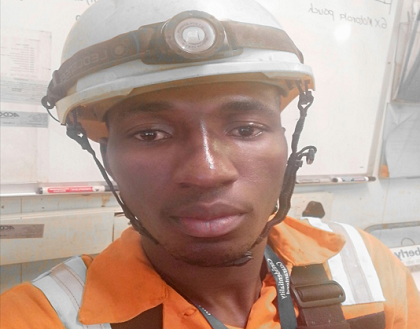
Upon completion of high school in 2008, Wilbard applied to study electrical engineering at one of the local universities in Namibia. He, unfortunately, did not get admitted on to the course he wanted to complete. It was a sudden turn of events for him which culminated in him having to enroll for another option.
However, he vowed that he would pursue a career in engineering by all means necessary. He dropped out of the course and took up a general electrical course at the local vocational institute.
Graduating in 2012, Wilbard went straight into employment. He began work for Namibia’s Elgin Brown & Hammer as a marine electrician. After gaining experience there for two years, he moved on to work for SABMiller Namibia, a multinational brewing and beverage company.
At SABMiller, he completed a course on SANS 10142 installation rules, which was a prerequisite to obtaining a wireman’s license so that he could formally become a professional certified electrician. At SABMiller, Wilbard saw that automation was taking over the electrical engineering field.
“I realized that it is imperative anyone in this field needs to cultivate a good understanding of automation in order to remain relevant. It is also necessary that one masters the basics of electrical engineering before tackling the automation part.”
Wilbard wanted to keep expanding his career and find new and exciting challenges. He wanted to go back into the marine industry while trying to find an institution that could further help him learn about the electrical engineering industry and the automation world. He went to work for Debmarine in Namibia in 2016. Debmarine is Namibia’s leading marine diamond mining company.
To further augment his skills and keep growing in his career, Wilbard decided in July 2018 to enroll for the 52726WA - Advanced Diploma in Applied Electrical Engineering (Electrical Systems). He doubled the course up with a national diploma in electrical engineering from a college in South Africa.
“I had been working for close to 7 years in the electrical industry before enrolling with EIT. Given the years of experience, I was under the impression that I knew it all, but one module into the course, I realized that my knowledge was only limited to the environment I was working in. Since then, I started seeing technical aspects from new perspectives.”
Wilbard says that his employer has been amazed by his improved workmanship and consistent compliance with engineering ethics - which he all chalks up to EIT’s training. He says he has become more productive and developed critical thinking skills.
The world is Wilbard’s oyster, as he decides what his next chapter is going to be. He says he is closer to achieving his career goals than ever before. For now, he is applying everything that he learned in his advanced diploma course:
“Life has been amazing ever since I left EIT. At this stage, I am still figuring out what I am going to do next, but I am thankful that EIT offers support to students even after graduating, and hence I still keep in touch with lecturers.”
Wilbard has floated the idea of doing a Bachelor of Science (Electrical Engineering) with EIT in 2021. In the meantime, he is enjoying his fulfilling job, where his daily challenges include maintaining, repairing, supervising, analyzing, and enhancing the electrical systems on-board the marine vessel. We wish him well in his future adventures.
Human ingenuity, and hobbyists — that’s what the world needs right now, aside from the medical professionals who are on the front lines of the coronavirus pandemic.
As hospitals around the world rush to take stock of the medical equipment they have at their disposal, engineers and engineering companies have been finding ways that they can contribute to the fight against COVID-19.
It turns out that the hobbyist engineer who has a 3D printer at home could potentially be an integral player in manufacturing items that can help secure public health. Kasey Martin, our in-house developer at the Engineering Institute of Technology (EIT), is putting his 3D printers to good work.
He currently works in the Philippines, which has put contingency plans into place to mitigate the spread of coronavirus. They are now in enhanced community quarantine, meaning the government has imposed a strict home lockdown with only essential movements for necessities and health services permitted.
“There has been an increase in checkpoints and uniformed personnel on the streets enforcing the quarantine. There has also been a rise in patients admitted to our health facilities. There is a great demand for any form of personal protective equipment (PPE),” he said.
Kasey had procured some 3D printers (the AnyCubic i3 Mega, the Creality CR-10, and Creality CR-2020) in a previous project that saw him printing parts for a weather station. When he heard that there was a shortage of PPE for the health workers and other essential workers, he jumped into action. He frantically searched for 3D printing templates for face shield frames.
One of the first considerations when printing a face shield frames is what filament to use and how fast it can be printed. Another factor is how safe the filament is for human use.
He explained, “For faster rollouts and ease of prints (easiest of all filaments types to use), we use standard PLA filaments. PLA stands for polylactic acid that is a bioplastic that usually comes from cornstarch as its raw material. It does not have any fumes (as opposed to ABS plastic) when printing, so it is safe for printing 24/7 in an enclosed office during this crisis.”
They then accessed open source templates that could be plugged into the 3D printers’ software.
“This is where the fun story starts. While thinking of a way we can help our front liners with alternative PPEs, we came across a Facebook group of 3D printing hobbyists. They were calling for help in 3D printing face shield frames that could be fitted with acetate sheets.”
“These face shields would then be given to front liners in the field and health centers nationwide. They did mention that, at first, the model required 3 hours to print. But the community also chipped in and gave them more optimal 3D printer profiles that made the frame print in a little over an hour!”
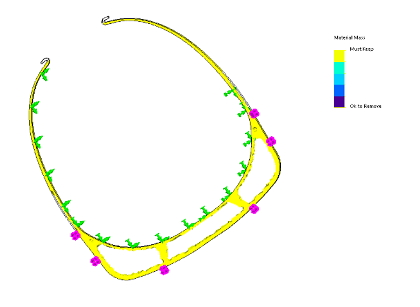
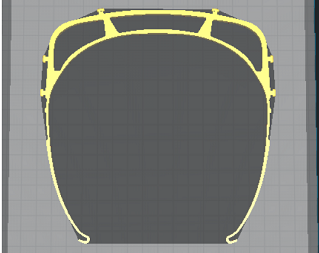
The crowdsourcing nature and the refining process has led to a much better-printed frame and enabled the printers to print quicker. The first iteration of the frame proved unsafe to use in a situation involving a COVID-19 patient.
To make a safer frame, he utilized a manufacturing methodology he learned from a mechanical engineer friend of his: topology optimization. He explained:
“Topology optimization mathematically optimizes your material layout based on certain constraints you put into it, like material load, for example.”
After optimizing the design and sticking to the directions of what would be safest to prevent essential health professionals from getting COVID-19, they produced a much safer frame.
The benefit of the new design was that a pair of frames could be printed at once, on a 200x200mm print bed. They posted their findings to social media and got positive feedback from friends in the medical field. Kasey and his team simply put a 0.52 mm ‘roofing’ on the frame that, if worn, would prevent any dangerous droplets from entering the shield.
The team managed to get a pair of frames printed in 40 minutes. Kasey has been sleeping over in the office to ensure that they produce as many frames as possible.
“We can produce about 50-60 face shield frames per day. We do most of our printing as fast as we can during the daytime, starting new prints every 1.5 hours. At nighttime, we slow down a bit and schedule prints every 3 hours so that we don’t mess with our sleep too much. Sleep is essential during the crisis. We can’t help other people if we get sick as well.”
Kasey says that other hobbyists can get involved in creating quality PPE equipment for health officials. Developing nations are specifically seeking assistance from the public.
“We have shared our modified design on Thingiverse so everyone who wants to contribute can freely download and get their printers to work. We are also in the works of forming an alliance of 3D printing hubs that should help cater to the number of requests we’ve been getting from various groups requesting these face shields.”
You can find Kasey’s design here.
Dear Colleagues,
Dr Jack Welch, a feisty chemical engineer, died earlier this month. You may not know who he was as he disappeared from the corporate scene a decade or so ago. He was the driven CEO of General Electric (or GE) – highly successful in growing the company to great heights – in fact, to one of the largest manufacturing and industrial companies in the USA (and indeed, the world). Whilst he was undoubtedly successful as a businessman, his argument on the need for the GE company to be a learning organisation resonates most with me.
It is arguably easier to dig stuff out the ground as a miner than to keep innovating with new products in a manufacturing organisation when one thinks of the huge competition from the likes of China. Certainly, miners have the challenge in that the prices they receive for their ore is predicated by buyers in a world market. One only needs to see the current impact of the dramatically lower oil price making the vast US-based shale fields uneconomic. However, if you are digging up a commodity in demand (e.g. rare earths); it is hard for any other firm to compete unless they have access to this ore. Manufacturing however does need continual improvements in one’s products and a huge level of innovation to stay in business.
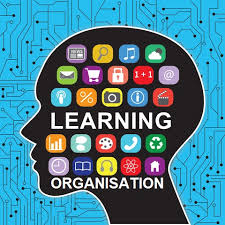
Hence, Jack Welch’s concept of GE being a learning organisation to allow for constant innovation makes huge sense.
Long Term Advantages
Jack felt that the only way a company could build a long term advantage over its competition was to become a learning organisation. This meant that every organisation has to empower each member of that organisation to continually learn, share knowledge and skills with others and then to use this knowledge in building better products and services. There must be an incredible thirst and enthusiasm for learning and innovation to build up the firm’s intellectual capacity.
Key Concepts
The idea behind a learning organisation is the need for everyone to keep learning new things. This is probably quite chaotic and indeed, anarchic in that many new approaches learnt may invalidate current ways of doing things. This means a fight to find the best solution and often a fairly dynamic work environment; but ultimately it means innovative products which make for a prosperous company.
It is important that managers drive the learning by example without fear. There is naturally the risk that you invest in training and educating employees that leave for better opportunities elsewhere. The opportunities for the organisation presented by encouraging learning are simply too good to worry about this aspect.
Learning isn’t just about attending a formal training course – this may be only a small part of the learning process. Learning is about encouraging the acquisition of knowledge and skills through mentoring, industry forums, the internet and a myriad of other more informal sources.
Learning is a slow uneven process with clear gains not always evident. One just has to be persistent and encourage a culture of learning and sharing knowledge. And in looking at opportunities to innovate.
Finally, in the application of learning to improving processes in search of better products and services there are often failures. This is all part of the learning process and should be acknowledged and accepted.
Jack’s comments included:
Some of Jack Welch’s more famous commentary:
"Each morning, I want every person at GE to know that two things will happen that day:
* Today, I will learn something from another GE employee, supplier or customer that will help me do my job better.
* Today, I will teach, support, mentor, advise and support the learning of a fellow GE employee.
Thanks to Elliot Masie for an interesting reflective piece on Jack Welch – a sometime contentious businessman but a visionary engineer.
Yours in engineering learning
Steve
Last Updated: 7 July 2020
This page provides information and advice for the EIT community on COVID-19. We encourage you to review this page regularly.
Online Student Information
We will post essential information and updates to our online student community via our regular channels including this website page, emails and newsletters.
For all general enquiries, please contact your Learning Support Officer via phone or email.
How is EIT responding to COVID-19?
In order to look after the safety (and long-term success) of our students, the Engineering Institute of Technology has appointed a COVID-19 Task Team and are monitoring the situation very closely. As an Australian headquartered organisation, we are following the advice provided by the Australian government and its agencies who we believe have taken a proactive and decisive approach in implementing measures to reduce the spread of the virus.
Our COVID-19 task team is led by our HR Manager, Ms Lisa Chisari and is ably assisted by Ms Caroline Patterson, our Compliance and Education Manager. Please be reassured that we are here to support you and will send you regular communiques regarding developments via our regular channels including this website page, emails and newsletters.
Will EIT continue to deliver their online programs?
EIT is delivering our online programs as usual. In a time of global volatility, your education is a key asset in securing your future and as members of our online learning community, you are well placed to continue with your studies amidst the current turmoil. We have over 15 years’ experience in delivering our unique, live online methodology that makes use of interactive webinars, an international pool of expert lecturers, dedicated learning support officers, and state-of-the-art technologies. Irrespective of the challenges COVID-19 present us, we have contingency measures in place to ensure we that we will continue to safely deliver our programs across the world.
How should I respond to COVID-19?
We encourage you to stay calm and to focus on keeping yourself, your family and friends healthy and safe. We also suggest you identify a few trustworthy sources of information and focus on that advice over the coming weeks and months. As members of the EIT community, we also respectfully ask you to demonstrate leadership and assist others if they need it.
It is important to prevent the spread of germs by thoroughly washing hands, sneezing/coughing into elbows and staying away from work if you are sick.
Further details from the Australian government can be accessed here.
Current On-Campus Student Information
We will post essential information and updates to our on-campus student community via our regular channels including this website page, emails and newsletters.
For all general enquiries, please contact our Student Services Manager, Miriam Munitz on 0459 677 212 or at
Latest Update
On Saturday 6th June 2020, the Western Australian government eased COVID-19 restrictions for the community. This includes gatherings of up to 100 people. It is with the current update in mind, that EIT will be re-opening the Bentley campus for all on campus Perth students for Semester 2, 2020. From the start of Semester 2 on 20th July 2020 (topic 1), Perth on-campus students will be required to attend all live tutorials and some assessments on campus, as well as being able to utilise the student room to study. EIT will continually endeavour to provide a safe environment for our students, so we will have disinfectant wipes and hand sanitizer in classrooms for students to use. However, we do ask that students persist with washing their hands and keeping social distancing. If the WA government makes any changes in the future, EIT will communicate immediately with students. In line with the Victorian government's COVID-19 restrictions, our Melbourne on-campus students will continue in our online learning environment for Semester 2, 2020 and until further notice.
If you have any queries, please contact our Student Services Manager, Miriam Munitz on 0459 677 212 or at
Can I travel to and from Australia?
Australia’s Prime Minister, Scott Morrison, has announced that Australia will close its borders to non-citizens and non-residents from 6pm AWST Friday 20 March, 2020 in a bid to contain COVID-19. This means that non-residents, non-Australian citizens will not be able to enter into Australia in the immediate future. Please be reassured that student and holiday visa holders already in Australia can remain in the country. However, the ban does mean that people with student and holiday visas who are currently out of the country will be unable to enter Australia. We understand that this may cause you some anxiety and wish to reassure you that the EIT family is here to support you. Please contact our Student Services Manager, Miriam Munitz if you have any concerns. You can contact her on 0459 677 212 or at
How is EIT responding to COVID-19?
We are aware that you will be feeling a sense of trepidation because of the presence of the virus, known as COVID-19. As governments around the world monitor and respond to the outbreak, we understand how difficult it is being far from home. We are committed to looking after your safety and have appointed a COVID-19 Task Team who are monitoring the situation very closely. As an Australian headquartered organisation, we are following the advice provided by the Australian government and its agencies who we believe have taken a proactive and decisive approach in implementing measures to reduce the spread of the virus.
Are EIT campuses open?
Perth, Bentley Campus
On Saturday 6th June 2020, the Western Australian government eased COVID-19 restrictions for the community. This includes gatherings of up to 100 people. It is with the current update in mind, that EIT will be re-opening the Bentley campus for all on campus Perth students for Semester 2, 2020. From the start of Semester 2 on 20th July 2020 (topic 1), students will be required to attend all live tutorials and some assessments on campus, as well as being able to utilise the student room to study. EIT will continually endeavour to provide a safe environment for our students, so we will have disinfectant wipes and hand sanitizer in classrooms for students to use. However, we do ask that students persist with washing their hands and keeping social distancing. If the WA government makes any changes in the future, EIT will communicate immediately with students via this website page or HE-OC Student Homepage on Moodle. The Moodle login can be accessed here. .
EIT’s Perth campus now has staff in attendance and students are welcome to come to campus if they have any questions or queries. Alternatively, please contact our Student Services Manager, Miriam Munitz if you have any concerns. You can contact her on 0459 677 212 or at
Melbourne Campus
EIT is committed to the safety of our students and staff during the ever evolving situation surrounding COVID-19. In line with the Victorian government's COVID-19 restrictions, our Melbourne on-campus students will commence or continue in our online learning environment until further notice. If you have a critical reason to come to campus, you must contact Student Services (
If you are a current on-campus student, all the information you need is available on the HE-OC Student Homepage on Moodle. The Moodle login can be accessed here.
If you have any questions please contact Student Services
Who can I ask for help?
As part of the EIT family, please also remember there are many support services available to you. The Australian Government has provided the following infographic summarising the support available to on-campus international students currently in Australia. You can download it here. Our Student Services Manager, Miriam Munitz is also here to assist you if you have any concerns. You can contact her on 0459 677 212 or at
What should I do to protect myself and others from COVID-19?
It is important to remember to practice good hygiene – cover coughs and sneezes, stay home if you are unwell and washing your hands often. We urge you to seriously consider avoiding any international travel for the foreseeable future. If you are expecting visitors from overseas or planning a trip home, please let us know your plans by contacting Student Services. It is important to note that if you are travelling or returning to Australia, you may not be able to enter Australia or will be required to self-isolate for 14 days. This applies to all travelers, including Australian citizens.
What information can I access about COVID-19?
Further information for on-campus students regarding COVID-19 can be accessed via the Study in Australia website or the Department of Education, Skills and Employment dedicated COVID19 website.
Further general COVID-19 information from the Australia Government is available as follows:
• To access the Australian Government COVID-19 Whatsapp channel, go to: aus.gov.au/whatsapp
• To access the Australian Government Coronavirus app, search for "Coronavirus Australia" in the Apple App Store and on Google Play
• To access updates from the Australian Department of Health visit their website here.
Prospective On-Campus Student and Education Agent Information
We will post essential information and updates to our education agent community via our regular channels including this website page, emails and newsletters.
For all general enquiries, please contact our International Education Agent Coordinator, Caroline Mackay +61 401 014 273 or
Latest Update
Australia’s Prime Minister, Scott Morrison, has now announced that Australia will be closing its borders to non-citizens and non-residents from tomorrow (Friday 20 March, 2020) in a bid to contain COVID-19.
Please note that the Engineering Institute of Technology will still be accepting and processing on-campus applications as per normal for forthcoming intakes. Please be reassured that if there are still travel restrictions in place for forthcoming intakes, your student will be able to commence their studies via our online delivery and then continue their studies on campus once they are able to. EIT has been delivering online programs, utilizing our unique delivery methodology for over ten years.
Further information from the Australian Government Department of Home Affairs can be accessed here.
Prospective On-Campus Student Information Webinars
Have questions? We are running a series of Student Information Webinars. Students can find details and register to attend here.
How is EIT responding to COVID-19?
As members of the global education community, we share a sense of trepidation because of the presence of the virus, known as COVID-19. As governments around the world monitor and respond to the outbreak, we understand you may have experienced disruption in assisting students with their international study goals. EIT are committed to looking after the safety of our students and have appointed a COVID-19 Task Team who are monitoring the situation very closely. As an Australian headquartered organisation, we are following the advice provided by the Australian government and its agencies who we believe have taken a proactive and decisive approach in implementing measures to reduce the spread of the virus.
What happens If my student’s visa is granted, but there is a travel restriction for the next intake?
On 15 March 2020, the Australian government advised that all travelers arriving from overseas will be required to self-isolate for 14 days. If this measure is still in place for our next intake, or if other countries have placed a travel ban, we wish to advise you that our students will be able to commence their program of study through our online methodology until it is safe to travel to Australia or physically attend on-campus.
Irrespective of the challenges COVID-19 present us, we have contingency measures in place to ensure we that we will continue to safely deliver our bachelor’s and master’s degrees to our student community.
Can students defer to the following intake if they don’t want to continue with the forthcoming intake?
Yes, this is possible.
How will students be supported while studying in Australia?
We wish to reassure you that all our students can access a wide range of support services when in Australia. Our on-campus students have been contacted to reiterate the support services available to them.
What information can I access about COVID-19?
Further information regarding COVID-19 can be accessed via the Study in Australia website or the Department of Education, Skills and Employment dedicated COVID19 website.
We firmly believe – as with previous crises – that we will emerge stronger and wiser from the experience when it does eventually pass. I believe that we will demonstrate to you – our valued supporters – that we can rise to the occasion and continue to deliver an outstanding educational experience.
Staff and Contractor Information
We will post essential information and updates to our staff and contractor community via our regular channels including this website page, emails and Teams updates. For immediate assistance, please contact our HR Manager, Ms Lisa Chisari or Ms Caroline Patterson, our Compliance and Education Manager on +61 8 9321 1702.
How is EIT responding to COVID-19?
We are aware that you will be feeling a sense of trepidation because of the presence of the virus, known as COVID-19. As governments around the world monitor and respond to the outbreak, we understand that you are experiencing disruption in your professional and personal lives.
In order to look after the safety (and long-term success) of all of our valued staff, we have appointed a COVID-19 Task Team and are monitoring the situation very closely. The team is led by our HR Manager, Ms Lisa Chisari and is ably assisted by Ms Caroline Patterson, our Compliance and Education Manager. As an Australian headquartered organisation, we are following the advice provided by the Australian government and its agencies who we believe have taken a proactive and decisive approach in implementing measures to reduce the spread of the virus. Please be reassured that we are here to support you and will send you regular communiques regarding developments via our regular channels including this website page, emails and newsletters.
What happens with COVID-19 escalating in some countries?
Irrespective of the challenges COVID-19 present us, we have contingency measures in place to ensure we that we will continue to safely deliver our professional certificates, diplomas and higher education degrees across the world.
Many you may already work remotely, and we have now implemented measures to allow all EIT staff to work from home should they need to do so.
For those who are working from a campus or office, in the event that we receive advice from the government that everyone must self-isolate and you cannot return to work, you will receive an SMS from EIT advising you that you cannot come to work accompanied by instructions to attend an online meeting/teleconference to receive further information from EIT.
In a time of global volatility, education is a key asset in securing an individual’s future. We can all be satisfied that our students, whether on-campus or online, are well placed to continue with their studies amidst the current turmoil. We have over 15 years’ experience in delivering our unique, live online methodology and are uniquely placed to support our students and our own learning and development.
What is the EIT travel policy?
- All work-related travel will not be permitted until further notice.
- Personal travel is your own decision, please note the following:
- If you feel even slightly unwell on your return from travel, do not come back to work until you feel 100% better. If you are situated in Australia and have travelled overseas, you must self-isolate for 14 days before returning to work.
- If you travel to another country and are forced into quarantine in another country, you can continue to use your annual leave. In these cases, EIT may allow you to go into a negative leave balance, if required.
- If you contract COVID-19 the standard sick leave policy applies, as it would with any illness.
- If you are advised to self-isolate at home, but are not unwell, you can work from home. We will need to sight official government documentation informing you to self-isolate.
What should I do to protect myself or what should I do if I become sick?
We encourage you to stay calm and to focus on keeping yourself, your family and workmates healthy and safe. As members of the EIT community, we also respectfully ask you to demonstrate leadership and assist others if they need it.
For those of you who work on campus or at an EIT office, please do not come to work if you feel unwell in any way. Or, if you work remotely, please advise your line manager if you cannot work as soon as it is reasonably possible.
It’s important that we prevent the spread of germs by thoroughly washing hands, sneezing/coughing into elbows and staying away from work if you are sick. We also need to stop the spread of inaccurate or ‘sensationalised’ information regarding COVID-19, as this can cause anxiety in some people as well as confusion.
Further details can be accessed here.
We firmly believe – as with previous crises – that we will emerge stronger and wiser from the experience when it does eventually pass. I would like to reiterate to you, our incredible and valued staff, that we can rise to the current challenges and continue to deliver an outstanding educational experience.
Mikkaela Hughes is an Engineering Institute of Technology graduate who recently earned her 52810WA – Advanced Diploma of Mechanical Engineering Technology. Mikkaela rose above adversity to pursue her career in engineering, and her story proves there is not just one pathway to take you from studying to the workplace, but that there are many approaches that can lead to success.
Mikkaela currently works in the tank manufacturing and refurbishment industry in South Africa. She is responsible for ensuring that her company provides products that comply with the design requirements set by clients. Mikkaela is fascinated with engineering because of the problems it presents.
 “I am a very open-minded, creative, and passionate individual who thrives on challenges and complexity. I feel that the field of engineering stimulates me and challenges me daily as I get to encounter many challenges on a daily basis, and hence grow from them,” she said.
“I am a very open-minded, creative, and passionate individual who thrives on challenges and complexity. I feel that the field of engineering stimulates me and challenges me daily as I get to encounter many challenges on a daily basis, and hence grow from them,” she said.
Mikkaela began studying mechanical engineering on a full-time basis in 2010, but due to financial restraints and life getting in the way, she was not able to continue her studies. As a result, she determined that she needed to start working.
“I started working in the engineering/construction management field in 2012, at the tender age of 20, and have been in this industry for about seven years now. During this time, I have been fortunate enough to be exposed to various aspects of the engineering field.”
While she hit the ground running with work, she began new academic endeavors as well. She completed her Basic, Intermediate, and Advanced Project Management Certificate during this time, as well as a Welding Inspection Diploma. At work, she gained exposure to pressure vessels, piping, structural steelworks, civil works, painting inspection, boilers, tankage fabrication, and maintenance as well as progressive tracking and resource allocation and planning.
Mikkaela managed to bring herself out of a difficult situation, equip herself with necessary skills and practical knowledge, and become a better practitioner in the engineering industry. With her previous industry experience, she began studying her 52810WA – Advanced Diploma of Mechanical Engineering Technology with EIT.
“I was highly impressed by the course content, which was so diverse and touched on many engineering aspects. This course covered content that I have not seen at other institutions. I was also impressed by previous students’ testimonies.”
Mikkaela says that her employers have been positive about her EIT qualification, and she is now determined to continue her academic journey and further enhance her career.
“Life after EIT has been blessed! I feel more confident in my working environment and more knowledgeable. Due to the completion of this qualification, and many more to come, I definitely see many doors being opened. I see myself maturing in this field and every aspect of engineering.”
She says that there is always a challenge to endure and solve in engineering - she maintains that it builds character and motivates her to keep going because she won’t rest until problems have been resolved. So far, her journey in engineering might have been different, but she has been able to gain momentum in her career.
“There were many challenges that stood in my way to complete my qualification. These included working 12-hour shifts seven days a week, financial setbacks of which I was not working for six months in 2018, having to relocate three times for work purposes, as well as the pressures and challenges and setbacks of life in general. But, my main goal was to persevere and complete my qualification and become the best engineer to pave the way for future engineers, particularly women in engineering.”
Determined to succeed, Mikkaela has done everything in her power to exact her own unique career progression. Her determination has been nothing short of impressive - but the journey isn’t over yet. She is considering several options that EIT presents in terms of degrees and certificates, so she can continue to build on her already substantive skill set.
“I would definitely encourage young people to pursue a career in the field of science, technology, mathematics, and engineering if they have an aptitude and passion for this field.”
Manga Olivier is a Chadanian engineer who completed his Master of Engineering (Industrial Automation) through the Engineering Institute of Technology. He currently works for ExxonMobil in Chad as an Instrument and Controls Engineer. His career has grown in leaps and bounds over the years, but his fascination with engineering began when he was younger.
“I was interested in engineering at a very early age. I like challenging situations in the realm of troubleshooting faulty devices, appliances, and equipment. I liked discovering new technologies from a young age too. All this led me to technical schools at college level.”
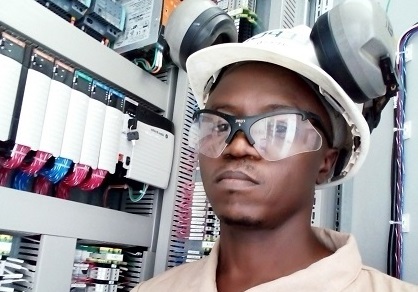
Manga started his engineering journey in school, and in 2002, he pursued a Bachelor’s Degree in Electro mechanical and Industrial Computing, which he finished in 2005. In 2007, he found employment at the Chad Brewery Company, where he worked from July to September.
In September of that year, he switched companies and began to work for Esso Exploration and Production Chad Inc. as an Instrumentation Technician. It would turn into an eight-year stint that would see him working indirectly for ExxonMobil. In those eight years, he would fulfill roles as an Instrumentation Technician, a Measurement Technician, a PLC Technician, and then his final role, which he is in today.
However, it was in mid-2015, Manga decided to broaden his knowledge in the engineering world once more. He began studying his master’s degree with EIT in July 2015 and graduated in October 2018. At the time of enrolling for the course, he was an Instrument Technician but knew he wanted to learn more so that he could progress his career in automation.
“When I started the course, I was working as an Instrument Technician, and when troubleshooting tricky issues related to PLC, I just got stuck and asked for help from a PLC Technician. As I progressed with the course, my troubleshooting skills were getting better and better, and finally, I was appointed as a PLC Technician.”
Right after he graduated, ExxonMobil promoted him to the role he is in today; Instrument and Controls Engineer. The daily responsibilities at his job include:
- Process engineering surveillance
- Place orders for instrument and control spare parts
- Initiate MOC for equipment when needed
- Make changes to PLC or DCS logics when required
- Tune process loops when the process variable (PV) is not following the setpoint (SP)
- Root cause analysis for equipment failures
- Manage small projects
- Edit or make changes to P&IDs
- Assessor and procedure editor
Manga is an excellent example of a dedicated worker with a hunger for knowledge. As a result, he has been internally promoted within ExxonMobil. Now, he is encouraging others to follow in his footsteps.
“I would encourage young people to pursue a job in whatever field they would feel at ease and have a good career plan because a job is one’s life. A good book to read to get started on automation is ‘Safety Instrumented Systems: Design, Analysis, and Justification’ by Paul Gruhn and Harry L. Chedie.”
He thinks that employers are already accepting the high-quality online qualifications EIT is offering. He is also highlighting the fact that the world of engineering has changed, which requires a broadened knowledge of all engineering disciplines - which traditional universities are unable to cater for.
“I cannot thank EIT enough for what lecturers gave me as knowledge during that training - I now have knowledge in almost all engineering fields. I feel like having boots on the ground when discussing engineering topics thanks to EIT.”
Reducing emissions in the mining sector is one of the key focuses for mining companies globally. The recent bushfire events in Australia have sparked conversation around how greatly fossil fuel emissions have affected climate change. The changing climate, experts say, is one of the reasons for the recent bushfire crisis that impacted the entire country.
Consequently, Rio Tinto will be spending US$98 million on a new solar plant at their US$2.6 billion Koodaideri iron ore mine in Western Australia. There will be extra expenditure for a battery energy system for the entire Pilbara power network, too.
 The solar photovoltaic plant will generate 34 megawatts and will supply the brunt of Koodaideri's electricity demand during peak operation times. The solar facility will see 100,000 panels absorbing the sun during the day, with the 12MWh battery storage system charging up.
The solar photovoltaic plant will generate 34 megawatts and will supply the brunt of Koodaideri's electricity demand during peak operation times. The solar facility will see 100,000 panels absorbing the sun during the day, with the 12MWh battery storage system charging up.
The solar plant will be fully in-service by 2021 - the year the mine becomes active too. Rio Tinto Iron Ore CEO Chris Salisbury told media, "The construction of our first solar plant in Pilbara is a significant milestone for the business and an important step in reducing our carbon footprint in the region. We are investigating additional renewable energy options in the Pilbara, as well as other opportunities to reduce emissions across our entire global portfolio, building on the 43% reduction in absolute greenhouse gas emissions since 2008."
Rio Tinto has been investing in solar photovoltaic setups with energy partners in Queensland, but the Koodaideri mine setup will one hundred percent owned by the company. They are working in tandem with the Western Australian Environmental Protection Authority to see where else they can decarbonize their mining operations.
They are contemplating wind projects, and further lithium-ion battery projects that can drive their carbon footprint down. Australian mining companies have been opting to build solar-gas hybrid power generation microgrids that power their operations. Mining companies are trying to meet the target of having 50% of the industry powered by renewables as soon as possible.
Juwi, a German company specializing in wind and solar energy, is trying to get more renewable energy into mines. It is hoping that one day mines might be powered by 100% renewable energy.
Dave Manning, juwi's global head of hybrid, told ESI-Africa, "Mines are most interested in solutions that can reduce costs and carbon emissions. The most advanced options to deliver this are hybrid systems that integrate solar, wind and batteries with diesel, gas or heavy fuel oil generators, without compromising reliability or power quality. We are already starting to see mines transition to fully electric operations, as there are multiple benefits. The economics of a 100% renewable energy site is almost there, and with the introduction of hydrogen, we are almost certainly going to see 100% renewable energy-powered operations in the near future."
Training engineers in renewables
Getting engineers trained up for the complexities of technological changes within the industry is what the Engineering Institute of Technology (EIT) is all about. As companies move away from fossil fuels, the electrical engineering industry continues to be transformed.
Renewable energy technologies are a specialist area that is forming a critical part of the industry's future. To understand the complexities of renewable energy systems, engineers who trained over a decade ago may need to upskill.
EIT delivers a live and interactive online Australian accredited 52764WA - Graduate Certificate in Renewable Energy Technologies. This program will equip you with the advanced skills and knowledge in the latest advanced technologies in power generation. Renewable energy is only becoming more critical in the mining industry, and therefore, mastering renewables is in the best interest of the 21st-century engineering student. Even working engineers can become proficient in these technologies by undertaking such courses.
EIT also delivers practical online programs in electrical engineering, and in electrical and instrumentation (E&I) engineering in the mining industry.
Works Cited
Batten, Kristie. "Rio Tinto to Build US$100M Solar Power Plant." Mining Journal, 17 Feb. 2020, www.mining-journal.com/sustainability/news/1381112/rio-tinto-to-build-ususd100m-solar-power-plant.
Zyl, Nicolette Pombo-van. "Key Renewable Energy Trends Have Proven to Power Mining." ESI, 4 Feb. 2020, www.esi-africa.com/industry-sectors/future-energy/key-renewable-energy-trends-have-proven-to-power-mining/.
Blog - Steve Mackay
EIT's Technical Director, Steve Mackay, enjoys keeping his blog up-to-date with useful tips and current industry matters for his fellow colleagues. He has a loyal and expanding following base reaching over 300,000 people around the world.
Student Stories
In this section you have the opportunity to read and listen to EIT students talking about the reality of the programs. Discussions are wide-ranging and include information about the study commitment required, the value of the qualification in their careers, the relevance of the subject matter, future pathways, and more. They provide valuable feedback for you to take into account before you decide to join one of our programs.
Career Information
Latest career information including industry research, podcasts, blogs, life hacks and general information about how you can make the most out of your career.
Education
Here you will find out more about the latest trends and developments within education worldwide, along with some helpful articles regarding study tips and keeping on track with your studies.
Developments
The latest innovation and inventions from the world of engineering can be found here. Learn about advances in technology and how they can make a real difference within your industry.
Announcements
Keep up to date with the latest announcements from the Engineering Institute of Technology. In this section you can read more about new courses, new recognition from professional bodies, our Excellence in Teaching Award, upcoming free webinars and much more.
Monthly Update
We understand that you may not have time to read all the articles that we post, so our monthly update gives you access to some fascinating articles which cover the best of the months news in a compact format.
